- Skip to primary navigation
- Skip to main content
- Skip to primary sidebar
- Skip to footer

Loire Lovers
To awaken your senses in the Loire Valley - Claire & Manu's Blog

Cathedral Saint-Gatien (Tours): visit + photos
by Clara BALAYER , Region Lovers | March 29, 2024 | no intrusive ads, no sponsored content, just some affiliate links - if you use them, we get a small commission (read more)
If you're visiting Tours, don't miss a visit to the cathedral! A true treasure of the city , it will delight architecture and history enthusiasts and art lovers alike. In addition to its typically Gothic composition, this religious building boasts an incredible collection of stained glass windows and a peaceful cloister .
In this article, we'll fill you in on the latest discoveries and anecdotes about this unusual monument! You'll also find all our tips and photos to help you visit Saint-Gatien Cathedral in Tours.

This guide is completely independent , based on our experiences. We visited the region anonymously, making our own choices and paying our bills in full.
Why visit Tours Cathedral?
Is saint-gatien cathedral worth it our opinion:.
Located right in the center of town, this majestic building is well worth a visit for its dazzling collection of stained glass windows . In addition to its 13th-century stained glass windows, Tours Cathedral is one of the very first religious monuments in France to feature a series of contemporary stained glass windows, which we found magnificent.

In the heart of Tours, in one of the Loire Valley's most beautiful cities , the Cathédrale Saint-Gatien is also the perfect place to stop off for a quiet stroll through its peaceful cloister. Listed as a Monument Historique, it is the only cloister still preserved of all the cathedrals in the Centre-Val de Loire region!
What's Tours Cathedral famous for?
Because it's one of the most beautiful cathedrals in the Centre-Val de Loire region ! We were amazed by its beauty, as impressive on the outside, with its majestic Gothic façade, as it is on the inside, with its vibrant collection of stained glass windows.

Cathédrale Saint-Gatien is also renowned for its architectural testimony . Four centuries of architecture await you: from the Romanesque base, to the radiant and then flamboyant Gothic ornamentation, to the Renaissance towers built around 1547. In short, there's something for everyone!
Finally, the cathedral is also famous for inspiring Balzac , the emblematic 14th-century novelist. A leader of realism, he made his mark with his masterpiece, La Comédie Humaine . A native of Tours, he couldn't resist sketching the superb Cathédrale Saint-Gatien! In this article, you'll find a few quotes from our illustrious author.
Our favorite moments
The cathedral is admirable both inside and out, but here are our favorites from our visit:
- At the risk of repeating ourselves, for us, the discovery of the stained glass collection is a must at Tours Cathedral. Our favourites? Those of the choir, truly impressive when the light shines through them. Believe us, you won't be able to resist their magic!
- The cloister's panoramic terrace offers another view of the cathedral. We particularly enjoyed getting up high and appreciating the architectural harmony of the cathedral, despite the changes it has undergone over the ages.

WHERE TO STAY IN Tours
In the city center
Enjoy the city, its restaurants and beautiful architecture.
- Hotel Ferdinand - check prices, pictures and availability
- Hôtel du Cygne - check prices, pictures and availability
- Hotel L'Adresse - check prices, pictures and availability

Near the station and around the city center
An early train? Or just a little more peace and quiet? Here are our recommendations:
- Hotel Les Trésorières - 5 stars - check prices, pictures and availability
- Aparthotel Central Parc Tours - check prices, pictures and availability
- Hotel Oceania L'Univers Tours - check prices, pictures and availability

In the countryside around
Looking for a bit of peace and quiet, without straying too far from the city of Tours? Here's our suggestion:
- Hotel Domaine de la Tortinière - 20 min away - check prices, pictures and availability
- Hotel Troglododo - unusual 25min away - check prices, pictures and availability

See our reviews of the best hotels in Tours
History in brief
Today's cathedral is the successor to three buildings:
- Around 338: Saint Lidoire, bishop of Tours, builds the first cathedral.
- 372: Saint Martin succeeds Saint Lidoire, hence the many motifs associated with this saint that you'll come across again and again during your visit!
- 590: Bishop Gregory of Tours rebuilds the cathedral and dedicates it to Saint Maurice.
- 1125-1150: Reconstruction in the Anjou style.

It wasn't until 1236, after a series of changes and fires (558, 1167), that work began on the cathedral as we know it today. They were commissioned thanks to the generosity of Saint Louis, Capetian King of France, and his mother, Blanche of Castile. The construction of the radiant choir dates from this period, and work will continue in this style:
- Around 1450: Completion of the nave in the flamboyant style for the upper sections.
- 1450-1484: Construction of the facade in the same style.
- 1507: Completion of the Renaissance-style north tower.
- 1534-1547: The crowning of the south tower in the same style marks the cathedral's completion!
Cathédrale Saint-Gatien was listed as a historic monument in 1862 and has been restored many times since. Between 2009 and 2019, for example, the French government invested 6 million euros in renovations, and further investments are planned to preserve this heritage jewel.

How to get there: Cathédrale Saint-Gatien, Tours
Where is tours cathedral.
- In downtown Tours
- Entrance is at Place de la Cathédrale, rue Lavoisier
- The cathedral is a 5-minute walk from the Musée des Beaux-arts de Tours.
OUR TIPS FOR RENTING A CAR IN Loire
- Compare prices on our preferred platform: DiscoverCars - one of the best rated sites.
- Choose a fairly compact car (many villages have narrowed the road).
- Think about full insurance (parking in big cities is really tight).
- There is a lot of demand, book it early .

To plan your itinerary, we recommend you visit the official website of the public transport network here .

If you're coming by car, you can park your vehicle on either side of the cathedral, on rue Fleury and rue de la Psalette, where numerous paying spaces are available, some of them handicapped. The Plaça des Turones parking lot is also a good alternative, and you can walk to the cathedral in just 3 minutes.
If you're coming by bike, you'll be delighted to find a number of bike stands in the cathedral square, just opposite the main entrance.
DISCOVER Tours
- Things to do in Tours
- Where to sleep in Tours: best hotels
- Where to eat in Tours: best restaurants - coming soon
- Rent a car in Tours
- Best castles around Tours
- Visit the Tours Museum of Fine Arts - coming soon
- Visit the Basilica of Saint Martin in Tours - coming soon
- Visit the Botanical Garden of Tours - coming soon
- Visit Saint-Gatien Cathedral
- Visit the Companionship Museum - coming soon

Practical tips: duration, timetables.
Best time to visit.
As with all religious buildings, we advise you to avoid service times if you want to make the most of your visit. To find out more, visit the cathedral's official website here.
Otherwise, you can visit us at any time of day, as we are not overcrowded. However, for a quieter visit, we advise you to come at opening time or at lunchtime. A final tip: visit the cathedral when the sun is high, to enjoy the magnificent play of light through the stained glass windows. So you can have fun reproducing these kinds of photos!

Length of visit and main difficulties
We advise you to allow between 10 and 40 minutes for a tour of the cathedral, taking in its façade, admiring its stained glass windows and discovering its secrets, before finishing with a visit to the Psalette Cloister. The cloister, gardens and terrace are managed by the CMN (Centre des Monuments Nationaux), which regularly stages temporary exhibitions. This may make your visit a little longer. Find out more here .
After our visit, we walked around the cathedral to Place Grégoire de Tours to admire its chevet (see photo below). We particularly liked this viewpoint and recommend this step aside!
Saint-Gatien Cathedral is suitable for people with reduced mobility and baby carriages (the entrance gate is accessible and the aisles are wide enough to move around). The cloister has a special tour program, which you can find here .

Advice on how to visit
The building has no specific itinerary, but for architectural purists, we recommend following a chronological route, from the oldest to the most recent. For this reason, we advise you to make your visit in the following order:
- Start directly with the 13th-century choir and ambulatory chapels,
- Retrace your steps and admire the 14th-century nave and transept,
- Round off your visit with a tour of the cloister . Although it was already the workplace of the canons in the Middle Ages, the buildings you can see today were only constructed between the 15th and 16th centuries.

A LITTLE MORE patience
All the photos, maps, information, good addresses to make your stay in the Loire Valley a success, will soon be gathered in a single ebook!
If you wish to be informed of the publication of our guide on the Loire , register:

Schedules and rates
Saint-Gatien Cathedral is open to visitors every day from 08:30 to 18:30. Access is free of charge .
The Cloître de la Psalette is only accessible from inside the cathedral. Cloister opening times vary according to the following, and please note that access is closed 15 minutes before closing time.
- March 1 to May 3 : 10 a.m. - 12:30 p.m. and 2 p.m. - 5:30 p.m.
- May 4 to September 7 : 9:30 a.m. - 12:30 p.m. and 2 p.m. - 6 p.m.
- September 8 to October 31 : 10 a.m. - 12:30 p.m. and 2 p.m. - 5:30 p.m.
- November 1 to February 28 : 9.30am - 12.30pm and 2pm - 5pm
Closing of the Cloister:
- January 1 , May 1, November 11 afternoon and December 25.
- Sunday mornings all year round, Mondays and Tuesdays from October 1 to March 31.
Tip: if you arrive in the afternoon, you may want to start with the cloister.
Access to the Cloître de la Psalette, on the other hand, is subject to a charge , as follows:
- Individuals: €5
- Free: under 18s, students, unemployed, disabled persons and accompanying adult

Guided tours
Saint-Gatien's Cathedral does not offer guided tours, but you can book group tours (minimum 6 people) in French or English with the Présence Cathédrale association by clicking here . Otherwise, the association's mediators are present in the cathedral from Easter weekend to November 11 (date of the winter Saint-Martin's Day), on Fridays and Saturdays from 10.30am to 12.30pm and from 3pm to 5pm.
We also recommend that you take the time to read the many explanatory charts scattered around Saint-Gatien Cathedral, particularly those that explain in detail the symbolism of the stained glass windows.

Tours is a gourmet city with a varied choice of restaurants from different horizons. Here's a small selection while we wait for our article on the city's best restaurants (coming soon!).
If you want to eat close to the Cathédrale Saint-Gatien, we'd advise you to do so:
- La Boulangerie de la Scellerie : just a 3-minute walk from the cathedral, this traditional bakery offers a wide selection of sandwiches, salads, quiches and pastries. We recommend you take the whole lot with you for an impromptu picnic in the nearby Jardin François Sicard.
- Restaurant Makeda : just a 4-minute walk from the cathedral, this Ethiopian restaurant serves delicious, perfectly seasoned dishes. Don't miss their freshly roasted, invigorating coffee!

Stunning architecture
As soon as we arrived in the cathedral square, we were struck by the beauty of its façade and the abundance of its ornamentation. But what makes it truly unique is the mix of styles it proudly sports!
A complex facade
This entrance alone represents 4 centuries of architecture, from the 12th to the 15th century. We immediately spotted the flamboyant Gothic style, with its flame decoration, slender arches and two 70-meter-high vertical towers. However, if you look closely, these towers are not topped with spires, as the Middle Ages would have it, but with domes. This stylistic effect is typical of the Renaissance period, during which they were modified. Likewise, the contrast between the sumptuous front decor and the sleekness of the tower, hidden behind it, the only vestige of the cathedral's Romanesque period, is striking. We were amazed at how well these different architectural layers coexisted!

Before entering the building, we spent a good while admiring the fine stonework that lines the entire edifice. The reason it's so finely chiselled is that it was built from very soft limestone, tuffeau, also used for the chateaux of the Loire Valley.

We also took time to observe the abundance of detail on the facade, stopping to consider the voussoirs of the three portals that pierce the base. In addition to the friezes of plants that seem to intertwine endlessly, we particularly liked the thirty statues of bishops and saints that hang there. They were remade in the 19th century by sculptor Pierre Damien, as most of the original statuettes were destroyed during the Wars of Religion or the French Revolution.
A grandiose interior
The interior of Cathédrale Saint-Gatien is typically Gothic, with a well-developed choir, exceptional stained glass windows and a string of columns. As you enter the cathedral, you'll be struck by the impressive network of arches that irrigate it. To describe it, Balzac speaks of a "forest of assembled columns" or even "an elegant labyrinth" in his work Jésus Christ en Flandre ,(1846). This idea of a maze is surely due to the length of the nave, which reaches 100 meters with its 8 bays, and the arrangement of its 29-meter-high pillars rising in a single jet from the floor to the vaults. This accentuates the idea of unity and slenderness, especially as the elevation is on three levels. We ourselves experienced the sense of immensity described by the author as we walked along the nave.

Light is also an essential component of Saint-Gatien Cathedral. In this image, you can see the jets of light escaping from the triforium, the narrow galleries typical of Gothic architecture, just above the arcades. We loved the sense of purity it gave off. Finally, from the choir, we recommend you contemplate the incredible perspective offered by the nave, which ends with a shaft of light at sunset.
A unique cloister
For us, the cloister of the Psalette is the highlight of the show at Saint-Gatien's Cathedral! It takes its name from the Psalette (from the Latin psallere, to sing psalms), a music school adjoining the cathedral that went by this name. Between the 5th and 10th centuries, the cloister was the workplace of the canons (religious who lived in community in a cathedral), but the version we're strolling through today dates from the 15th century. After visiting the three galleries, we enjoyed a timeless break in the gardens.
We then took the magnificent spiral staircase. Restored in 1998, it is said to have been built in the 16th century by architect Bastien François, as a replica of the Château de Blois. Upstairs, you can see the scriptorium, a room dedicated to the manuscript writing for which the canons of Saint-Gatien were renowned, and their bookshop, which preserved the chapter books.

Our favorite part? Enjoy breathtaking views of the cathedral from the panoramic terrace. A mysterious atmosphere emanates from this traverse, where the legacy of time is palpable. Watch out for the gargoyles watching you!

While we loved our serene experience in the cloister, Balzac depicts it quite differently in his work Le Curé de Tours , published in 1832. He drew inspiration from it for the décor of a house adjoining the cathedral, where two priests quarrel. And, it seems, he doesn't see it the same way we do!
Judge for yourself: "This place is a desert of stones, a solitude full of physiognomy, and which can only be inhabited by beings who have either reached complete nullity or are gifted with prodigious fortitude." Fortunately, this point of view is fictional, and there's no doubt that you, like us, will be charmed by this little haven of peace in the middle of Tours! In fine weather, deckchairs are even available for longer strolls.
The jewel of Tours Cathedral: its stained glass windows
The cathedral's stained glass windows are a veritable painting of light, and well worth a visit to Tours. Take the time to appreciate each of their color variations and read their dedicated explanatory labels to learn more about their specific symbolism.
The choir windows
The 800m2 of stained glass in the cathedral's choir can truly be described as a jewel. Looking at this dazzling palette is enough to make you dizzy! This is one of the finest examples of 13th-century medallion stained glass in Europe! Perfectly intact and complete, they fascinated us with their brilliance and striking color play.

Take the time to admire the different motifs that adorn the three roses and make the cathedral's interior come alive! You'll see cross petals, shamrocks and quatrefoils. Despite the fact that two centuries separate the sunset rose (15th century) from the roses in the transept (18th century), the harmony of colors is spot on.
To capture their splendor, who better than the illustrious Balzac: "The lace of the roses suddenly shone. Every vein, every carved edge, the smallest line became silver. The sun lit fires in all the stained glass windows, whose rich colors twinkled like stars." (Source: Jesus Christ in Flanders ,1846).

Contemporary stained glass
First, in the north arm of the transept, you'll discover nearly 200m2 of stained glass created in 2011 by artist Gérard Collin-Thiébaut and master glassworker Pierre-Alain Parot. We particularly liked the artist's decision to blend religious iconography with contemporary representation. If you look closely, you'll see the dialogue between the photographs of passers-by that the artist has observed in the vicinity of the cathedral and the figure of Saint-Martin that he has reproduced.
We were pleasantly surprised to see how well these contemporary stained glass windows complemented the medieval windows in the triforium and rose on the north façade. However, this stained glass creation was based on technical innovations such as glass printing technology and computer assistance. It just goes to show that the art of stained glass knows how to renew itself and endure!

We particularly liked the stained glass window above. Not only do red and blue vibrate in unison for a dazzling contrast, but the association of symbols is also very strong. Indeed, under the red spot, you can first make out the infamous procession of homeless tents on Paris's Canal Saint-Martin. Just above, the red-orange sun symbolizes the miracle of Saint Martin's globe of fire. He is said to have been crowned with this globe after stripping off his clothes to clothe a beggar just before officiating mass. We thought it would be a good idea to bring together a religious episode from the past and at the same time encapsulate a social phenomenon of the early 21st century, namely extreme precariousness. Could this be a hidden message from the artist to encourage people to help each other?

Then, in the cloister library, you'll find stained glass windows created in 1960 by master glassworker Max Ingrand. They represent a modernized vision of the "liberal arts", disciplines such as rhetoric and astronomy that were taught in the Middle Ages. Why is this? To recall the original function of this cloister, which housed a music school where young choirboys were trained.
A cathedral full of surprises
Tours Cathedral will surprise you with the little details you'll find along the way. Keep your eyes peeled!
The royal tomb
In the first south chapel of the ambulatory, you'll find the royal tomb. Carved in Carrara marble around 1500, it houses the remains of Charles VIII and Anne of Brittany's two children, Charles and Charles-Orland. Initially installed in the Basilique Saint-Martin, it only moved to Tours Cathedral in 1834, spared from the Revolution thanks to its beauty. It is recognized as a major work!

What did we like in particular? The stylistic mix of this tomb with:
- On the one hand, the macabre realism of these small recumbent figures by sculptor Michel Colombe, in the pure French tradition that has its roots in the medieval age.
- On the other, the finesse of the decorations, typical of the Italian Renaissance of the 15th century: winged paws, dolphins at the corners, vegetal frescoes and "putti", little naked angels. The vat is by Jerome de Fiesole, brought back by King Charles VIII from his Italian campaign.
Consecrated in 2018, this altar is worth a look for the purity of its stone (a monolithic block of marble limestone from Burgundy) and its engraved motif. Created by artist-sculptor Alicia Drouillet, it depicts 8-petal Gothic roses, a motif identical to that spotted by architects in various parts of the cathedral (notably the façade towers) and replicated here for symbolism.

We loved the contrast between the delicacy of this engraving and the mass of this altar, which weighs almost 2800kg when hollowed out! A pretty Latin cross hides in the middle of this subtle damask. Unlike the photo above, where it appears to be highlighted, you'll need to pay close attention to distinguish it.
Frescoes and other remarkable features
Another special feature of the cathedral is its frescoes! They covered the entire wall in the 13th century, and despite successive vandalizations, some have been preserved. One of the chapels in the ambulatory features the "Charity of Saint-Martin" , a major motif in Christian iconography . It features the figure of Saint Martin (circa 316-397), cutting off his cloak to share with a beggar.

Two details surprised us: the fact that Saint Martin is on horseback and that he carries a sword. Indeed, at the time of this episode, he was a young legionary in the service of the Roman Empire, not yet baptized. It was only the following night, when Christ appeared to him in the guise of a beggar, that he decided to convert and dedicate his life to the Faith. We were overwhelmed to see this heritage, almost intact, and to learn more about its religious origins!
In addition to our favorites detailed above, you'll also find..:

Le Tabernacle de Chambord : Dating from the 17th century, it was confiscated during the French Revolution, then donated by Louis XVIII to the Carmelite monastery in Créteil, before arriving at Chambord in 1963. Its size (1.80 m high by 2.70 m long) is exceptional, given that its sole purpose is to hold the ciborium, with the hosts consecrated at Mass. Located in one of the choir chapels, you'll also notice its delicate craftsmanship, the structure being made of oak but veneered with ebony and ivory.

The Great Organ : located in the south arm of the transept, you won't want to miss it! It was donated in 1468 by Hélie de Bourdeilles, Archbishop of Tours, before being adorned in 1521 with a dozen cherubs. We loved the contrast between the lustrous wood and the glass in the rose window just behind it! We invite you to take a look at the details of the entire woodwork, as since 1984, the oak buffet and its 818 antique pipes have been listed as a "Monument Historique". And if you're lucky, you may be able to attend organ concerts in August and September (see here ).
Subscribe to our Newsletter
- Get away from it all with Region Lovers' beautiful destinations!
- Once a month
- Advertising-free

Frequently asked questions
When to see the cathedral illuminated.
No information is given on the cathedral's official website, so we suggest you refer here to find out more from the Tours tourist office. Please note, however, that the cathedral is lit at dusk until 11pm all year round. So it may be worth coming back for a night-time visit from the outside!

What to do near the cathedral
There are many tourist attractions within easy reach of Cathédrale Saint-Gatien:
- Musée des beaux-arts de Tours : housed in the former bishop's palace, this museum boasts a varied collection of works ranging from Antiquity to contemporary art (see our dedicated article soon).
- The Château de Tours : a majestic 15th-century building in dialogue with photography exhibitions from the Jeu de Paume museum in Paris (see our dedicated article coming soon).
- The botanical garden : a wonderful natural setting for a break in your day of sightseeing! (see our dedicated article coming soon)
To find out more about the mysteries of the city of Tours and explore its nooks and crannies, you can book a tour of its historic center: See prices and availability .
Tours is also an ideal city for those wishing to visit the Loire Valley and its castles, including the famous Château de Chambord, for which you can book a guided day tour from Tours: See prices and availability .
And if you're in the mood for a bucolic jaunt, check out our article on the 12 most beautiful villages in the Loire Valley here .
Why Saint-Gatien?
The cathedral was originally called Saint-Maurice! It was so named as early as 590, when Bishop Gregory of Tours decided to rebuild it, and it was dedicated to Saint Maurice. Its reconstruction took so many centuries that the inhabitants of Tours invented the saying "as long as the construction of Saint-Maurice"! It wasn't until the 14th century that the name was changed to Saint Gatien, a bishop commissioned by Pope Fabien to evangelize Touraine around 250 AD.
PLAN YOUR TRIP IN Loire Valley
The castles of the Loire Valley
- Best châteaux in the Loire Valley
- Sleeping in a castle in the Loire Valley
- Best family castles
- List with over 100 castles

Other places to explore
- Best things to do in the Loire Valley
- Most beautiful towns along the Loire
- Most beautiful villages
- Most beautiful gardens
- Best things to do in Nantes
- Things to do in Angers
- Best things to do in Saumur
- Things to do in Amboise

- Where to stay in the Loire Valley
- See our tips for renting a car in Nantes , Angers , Tours , CDG , Orly or Beauvais ...
- How to get to the Loire Valley - article to come
- Itineraries: 3 days - 4 days - 5 days - 1 week
- Weekends: unusual

HE MADE THE TRIP Manu

SHE WROTE THE ARTICLE Clara
The 10 commitments of region lovers.
- Visit all the places we tell you about.
- For each city, sleep in at least one hotel, visit the ones we recommend.
- For each city, eat in at least one restaurant, visit the ones we select.
- Pay all our bills in full, refuse any partnership or sponsorship.
- Update our articles periodically, with the help of our readers.
- Enrich our articles with our on-site experiences.
- Use 99% of our own photos
- Have a reasoned and transparent use of the AI tool, which we feed with our locally verified information.
- Inform about the traveler/writer pairing that gave birth to the article.
- Tell you what we do, and do what we tell you!
Claire and Manu
Learn more about the team and our history.

SEARCH OUR SITE
Our multi-destination blogs.
Regionlovers.fr
ZigZagroadtrips.com
OUR OTHER REGIONS TO DISCOVER
LoireLovers.fr
NormandieLovers.fr
ProvenceLovers.fr
CanariasLovers.com
CHANGE LANGUAGE
Mentions Légales / Conditions d’utilisation / Politique de confidentialité
- AI Generator
Sorry, your search returned zero results for “tours_cathedral”
Have you tried doing the following:
Check for spelling errors or typos
Clear search filter options
Use fewer keywords
Category : Cathédrale Saint-Gatien de Tours
Subcategories.
This category has the following 5 subcategories, out of 5 total.
- Exterior of Cathédrale Saint-Gatien de Tours (4 C, 69 F)
- Interior of Cathédrale Saint-Gatien de Tours (3 C, 173 F)
- Cathédrale Saint-Gatien de Tours in Médiathèque de l'architecture et du patrimoine (114 F)
- Cloître de la Psalette (1 C, 117 F)
- Tours cathedral (Palissy protection) (3 C)
Media in category "Cathédrale Saint-Gatien de Tours"
The following 21 files are in this category, out of 21 total.

- Churches in Tours
- Gothic cathedrals in France
- Monuments historiques in Tours
- Monuments historiques in Indre-et-Loire (cathedrals)
- Via Turonensis
- Roman Catholic cathedrals in France
- Churches in the Roman Catholic Archdiocese of Tours
- Base Mérimée
- Monuments historiques in France by name
- Monuments historiques classés
- Mérimée with PA parameter
- Cultural heritage monuments in France with known IDs
- Mérimée ID same as Wikidata
- Uses of Wikidata Infobox
- Uses of Wikidata Infobox with maps
- Pages with coordinates
Navigation menu
- Accommodation
- Towns & Villages
- Places to visit
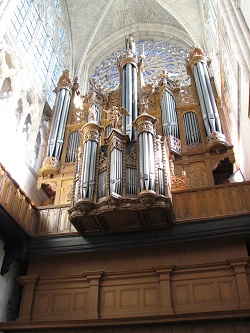
Cathedral Saint-Gatien
Monument in tours.
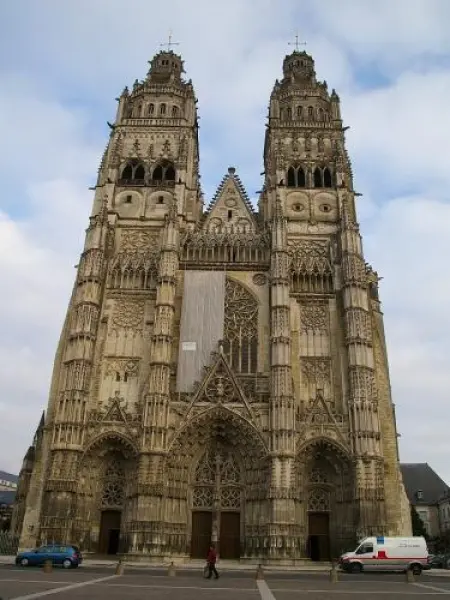
A true masterpiece of Gothic art, the Saint-Gatien cathedral sits in the heart of old downtown Tours, in Indre-et-Loire . Today listed building, it was built between the thirteenth and sixteenth century on the remains of an ancient Gallo-Roman city. Under royal patronage, the building has seen all the kings of France since Louis VII become canons of honor, showing its importance in the kingdom.
Remarkable, the Saint-Gatien harmoniously blends the High Gothic, with its impressive bedside shrine, Gothic in its finely sculpted façade and elegantly lit at night, through the Renaissance style that reveals the crowning of two towers.
On the bedside, one of the most beautiful Gothic works of the thirteenth century, visitors will discover many statues animating the walkway and include representatives of the patron saints of the cathedral.
Inside the religious building, hard to remain indifferent to the beauty of the tomb of the children of Anne of Brittany and Charles VII with its incredible sculptures of the sixteenth century lit by stained glass windows. In the north, it is possible to admire a Renaissance cloister classified as an historic monument, while in the south, the palace of the archbishop now houses the Museum of Fine Arts in the city.
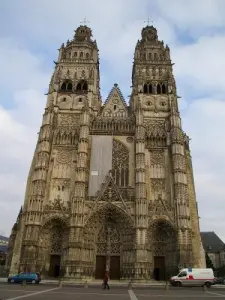
Other monuments nearby
Leisure activities.

Restaurants
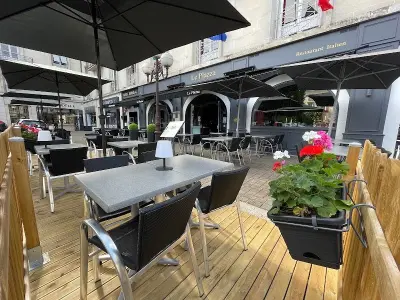
Bed & breakfasts

Vacation rentals
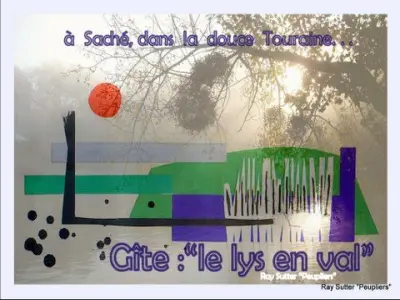
Related articles Cathedral Saint-Gatien
Basilica of Saint-Martin in Tours visitor guide

Visit Basilica of Saint-Martin in Tours, France
The Basilica of Saint-Martin is an important church in the location where Saint-Martin was buried, in the centre of Tours in the Indre-et-Loire department. You will visit the town as you explore the Loire Valley.
Discover the basilica of Saint-Martin in Tours
France This Way review: although it is not the principal religious monument in Tours, the basilica of Saint-Martin is an imposing church in the town centre with an interesting history (several relics of the earlier basilica on the site can also be seen), and merits a visit as you explore the historic centre of the town.

A church has stood in this approximate location since the 5th century, after Saint-Martin of Tours died in 397 AD and a small oratory was built over his burial site in 437 AD. By the end of the 5th century a basilica had been built and in the following centuries this was further enlarged.
At the beginning of the 9th century the basilica was classified as a collegiale church, and approximately 200 monks were based here.
Rebuilt and expanded in the 11th century, and further expanded in the 13th century, the basilica became one of the largest churches in the Christian world. Several chapels and a double ambulatory behind the altar were part of this imposing structure.
The church was looted in the 16th century and became a stable after the French revolution. By the end of the 18th century the basilica was in a very poor condition after the vaults had collapsed and it was demolished as part of a plan to improve traffic flow through the centre of Tours.
The Tour de l'Horloge, the Tour Charlemagne and one side of the cloister are all that remain of this original structure.
The Rue des Halles (the road in front of the current basilica) was constructed approximately in the position of the east-west axis of the original basilica, and Rue Descartes (the road to the side of the current basilica) is in the position of the south transept of the original basilica.
Light coloured paving stones can be seen in Rue des Halles that mark the position of the columns in the nave in the original basilica.
The current basilica was built at the end of the 19th century in the neo-byzantine style after the tomb of Saint-Martin had been re-discovered in 1860, underneath a house. The building of the church followed long arguments - some believed the new basilica should be rebuilt in the same location and with the same dimensions as the original, with the Rue des Halles being closed and built on.
This plan was ultimately rejected and the basilica we see today is much smaller than the original.

The photo above shows the layout and size of the original basilica of Saint-Martin - I have outlined the area in red to make it more visible. This also helps to understand where the Tour de l'Horloge and the Tour Charlemagne were in the original church.
The current basilica of Saint-Martin is oriented north-south instead of the original east-west (which is much more common in churches) because of the constraints of the land available.
There is a large bronze statue of Saint-Martin blessing the town from the top of the dome, recently restored, and an engraving on the facade that celebrates the town having Saint-Martin as patron.
The church is typical of neo-byzantine churches from this period. The interior of the basilica has a main nave, separated from two side naves by rows of columns in polished granite, and a large painted dome above the transept with a row of windows to allow light to enter the structure.
Inside the crypt of the basilica you can see a replica of the tomb of Saint-Martin, although most of his relics are no longer in the church.

There is no charge to enter the basilica of Saint-Martin when you visit Tours.
Attractions nearby
The principal historic religious monument in the town is the Tours Cathedral with the La Psalette Cloisters . For other highlights see the Tours city guide .
See more churches in France . You can find more travel ideas in the Indre-et-Loire guide and the Loire Valley guide .
See also Find Basilica of Saint-Martin in Tours hotels
Photos of Basilica of Saint-Martin in Tours
Click any picture to start the gallery

Arrange a visit to Basilica of Saint-Martin in Tours
Book hotels, car hire and flights.
- Book a visit
Hotels in Basilica of Saint-Martin in Tours
Booking.com: best prices
See Basilica of Saint-Martin in Tours hotels

Reserve excursions
Map of basilica of saint-martin in tours and places nearby, visit near basilica of saint-martin in tours with france this way reviews.

Tours is a large important town with numerous monuments, gardens and medieval buildings, and is also well placed to explore the west of the Loire Valley

Tours Cathedral and La Psalette Cloisters
The la Psalette cloister and the cathedral of Tours together make a very impressive religious monument with various architectural styles

Chateau de Villandry
The rooms at Chateau de Villandry can be explored, but it is the world famous French style gardens here that will hold your attention the longest

Azay-le-Rideau
The village of Azay-le-Rideau is best known for its castle but also has a pleasant centre with a historic church and mill to explore

Langeais is a small town with a pretty town centre, best known for the castle in the town

Chateau d'Azay-le-Rideau
Not the most luxurious or largest castle in the region, it is the beauty and waterside location that gives the Chateau d'Azay-le Rideau its special charm
... or see ALL recommended places to visit in Indre-et-Loire
The French version of this page is at Basilica of Saint-Martin in Tours (Francais)
French Places
We can help you visit any town, village or region of France...
Popular & Useful
① Ideas & inspiration ② Maps of France ③ Explore by region ④ Route planner ⑤ Places (by dept.)
France This Way copyright 2006 - 2024
- Cookies & privacy
- Index of places
You are using an outdated browser. Please upgrade your browser to improve your experience.
- Sacred Destinations
Sacred Sites, Religious Places, Pilgrimages
- Destinations
- Tours Cathedral
Photos of Tours Cathedral
This gallery of 5 photos accompanies our article on Tours Cathedral . Click any image to enlarge or start at the beginning for a virtual tour.

A Guide to the Best Things to do in Tours, Loire Valley
By: Author Sophie Nadeau
Posted on Last updated: 13th March 2023
Categories France
Last Updated on 13th March 2023 by Sophie Nadeau
Nestled in the heart of the Loire valley, a region of France well known for its many historic châteaux, the town of Tours has kept many vestiges of its medieval past. Here’s a guide to the best things to do in Tours , as well as what to know before you go.

What is Tours known for?
Tours cathedral, château de tours, musée des beaux arts de tours, relax in the park prébendes d’oé garden, enjoy the cherry blossom, harry potter store (les trois sorciers), musée du compagnonnage, walk along the river loire , take a boat ride , flood level, get a drink at place plumereau , charlemagne tower , clock tower, basilica , christmas market, take a day trip to amboise, take a day trip to the loire valley château, boll n roll, where to stay in tours.
Tours is a city located in the Loire Valley region of central France, known for its rich history, architecture, and cultural attractions. Among them are the Château de Tours and the Cathedral of Saint Gatien.
The Musée des Beaux-Arts de Tours is another notable attraction, featuring a collection of over 12,000 works of art, including paintings, sculptures, and decorative arts.
The city also boasts the picturesque Place Plumereau, a popular spot for dining and socialising surrounded by medieval half-timbered buildings, and Les Halles de Tours, a bustling indoor market.
Tours is also known as the gateway to the Loire Valley, home to numerous historic châteaux, including Château de Chenonceau, Château de Chambord , and Château de Villandry, making it a popular destination for history, culture, and food enthusiasts. For more inspiration, check out our suggested Loire Valley itinerary .

Things to do in Tours
Truth be told, one of the best things to do in Tours is to stroll around the old town, which is characterised by its little lanes and timber-framed architecture.
Old Tours makes up the streets surrounding Place Plumereau. Largely pedestrianised, the little cobbled lanes are perfect for snapping stunning medieval-esque photos.

Widely regarded to be one of the most beautiful cathedrals in France , Tours Cathedral is officially known as Cathédrale Saint-Gatien and was constructed between the 12th and 16th-centuries.
Today, highlights of the Gothic ecclesiastical building include original 13th-century stained glass windows and several ornate stone-carved tombs of the children of Anne of Brittany.

As is the case with many medieval towns, Tours boasts its own Château with roots dating back to the Middle Ages. The Château de Tours was constructed in the 11th-century and was once home to the Lords of France. Today, the castle can be visited for a small fee.

Those who wish to enjoy some of the finest paintings held in the Loire Valley need to look no further than the Museum of Fine Arts. Highlights of the art museum, which is set against the backdrop of the bishop’s former palace, include fine Italian paintings and two paintings by Andrea Mantegna.
One of the most beautiful places to visit in Tours is the park of Prébendes d’Oé, which is a beautiful green space that is centred around a central lake teeming with ducks. When the weather is warm, it’s a great spot to people watch and sit on a bench in the sunshine.
If you happen to be visiting Tours in the summertime, then one of the best places to soak up some summer sunshine is at Guinguette Tours (official name Guinguette de Tours sur Loire), which is an open-air terrace along the banks of the River Loire from the late Spring to early Autumn.

It may surprise many, but Tours is actually a fantastic place to enjoy gorgeous cherry blossoms during the springtime. The best places to enjoy cherry blossom in Tours is along rue Constantine, on the adjacent rue du commerce, and around the train station.
Please note that the pink cherry blossom around the train station is slightly later blooming than that in the centre of town, which tends to bloom in the last couple of weeks of March. If you visit during the last week of March then you will be sure to see at least a few trees in bloom!

One of the more unusual shopping experiences to have in Tours is to head to the wizarding store along Rue du Commerce. Head in at any given moment and you’ll soon find a wide selection of magical collectibles and clothing inspired by the Harry Potter series.

Set against the backdrop of a former abbey dedicated to Saint-Julien, yet another museum in Tours which is worth checking out is the Musée du Compagnonnage, which is all about trade-guild history.
One of the most famous rivers in France is the Loire, and this is what gives the area its name. As well as being the 171st longest river in the world, the Loire is the longest river in France and the 3rd longest in Europe.

One of the most gentle and relaxing ways to get a different view of the Loire Valley is by taking a boat ride along the River Loire. One agency that proposes tours down the river in a flat-bottomed wooden river boat is the Boutavant Association. Find more details here.
If you’re looking for a unique hidden gem of Tours that’s a little off the beaten path, then you can head to the flood level marker that lies along the banks of the River Loire. The marker details all recent flooding levels, as well as more historic ones.

The very beating heart of Tours is Place Plumereau, which is a big open square with sprawling cafés, restaurants, and eateries. While the brasseries on the square are not of the best quality, it’s one of the best spots in the city to grab a drink and people watch when the sun is shining.

One of the more historic buildings you’ll see when wandering around town is the Charlemagne Tower. This is known as the tower of Charles the Great in English and is now all that remains of the original Basilica of St. Martin of Tours. Local legend suggests that it was in this basilica or close by that Charlemagne interred his wife.

Known as the Tour de l’Horloge in French, the clock tower is situated in the vieux-ville portion of Tours and dates back to the 11th-century, though much of what you see today was added in the 16th-century.

Tours Cathedral is not the only important ecclesiastical building in Tours. There is also the Basilica of Saint Martin (known as the Basilique Saint Martin in French) which was constructed to replace an earlier one of which the Charlemagne Tower is the only remaining remnant. Today, a visit to the interior of Basilica is free and open every day of the week.

Visitors who frequent the ancient settlement during the winter will soon discover the Tours Christmas Market, which takes place on an annual basis. For more inspiration, be sure to check out our Tours Christmas Market guide .

Tours is the gateway city to the Loire Valley, making it a great place to base yourself from which to explore the wider region. One of the most delightful towns near Tours is Amboise, which is where there’s a wonderful château and medieval town.

Of course, history buffs will be well aware that the Loire Valley is best-known for its amazing Châteaux. Some of the most famous Châteaux in the region are Château de Chambord and Château de Chenonceau.
The easiest way to get to the Loire Valley Châteaux is by car as many of the castles are not served by public transport. Alternatively, if you want all of the transportation details taken care of for you, then you can book a guided tour like this one.

Where to eat
In the French countryside outside of Paris, it can be hard to find vegetarian options and any vegan offerings are even harder to find still. One particular favourite of mine when it comes to somewhat healthy fast food in Tours is Boll n Roll, where there are several meat-free options on the menu.
Thanks to its fairly large size and popularity, there are a number of different places to stay in Tours to suit almost any budget and taste. Here are some of the best places to stay in Tours based on web-reviews and location:
Budget: One of the most affordable and yet cosy places to stay in Tours is The People. This chic hostel offers private rooms as well as mixed-gender and female-only dorms. There’s a bar onsite with a terrace. Check prices and availability here.
Mid-range: Those in search of an affordable luxury option when it comes to staying in Tours can check out this cosy little hotel. Amenities include air conditioned rooms, free Wi-Fi, and a fairly central location. Check prices and availability here.
Luxury: For the ultimate luxury experience during your time in Tours, consider booking yourself a stay at this four-star hotel. Highlights include a pool and spa, as well as a fitness centre. Check prices and availability here.
Enjoyed reading about the best things to do in Tours? Pin this article now, read it again later:

Sophie Nadeau loves dogs, books, travel, pizza, and history. A Francophile at heart, she runs solosophie.com when she’s not chasing after the next sunset shot or consuming something sweet. She splits her time between Paris and London and travels as much as she can! Subscribe to Sophie’s YouTube Channel.
This site uses Akismet to reduce spam. Learn how your comment data is processed .
This website may ask your browser to store cookies. See our Cookies Policy for more information about our use of cookies.
- site navigation
- main content
- +44 (0)20 8742 3355 +44 (0)20 8742 3355
- [email protected]
- +44 (0)20 8742 3355
The Cathedrals of England - Ely, Lincoln, Durham, York, Coventry, Gloucester, Bristol, Wells, Salisbury, Winchester
A study of England’s greatest buildings – their history, architecture, sculpture, stained glass and current life.
Built between the Norman Conquest and Henry VIII’s Reformation, with Coventry Cathedral a moving exception.
An organ recital exclusively for us, and many other special arrangements.
Print itinerary (2024)
Print itinerary (2025)
25 Sep - 03 Oct 2024 £3,290 Book this tour
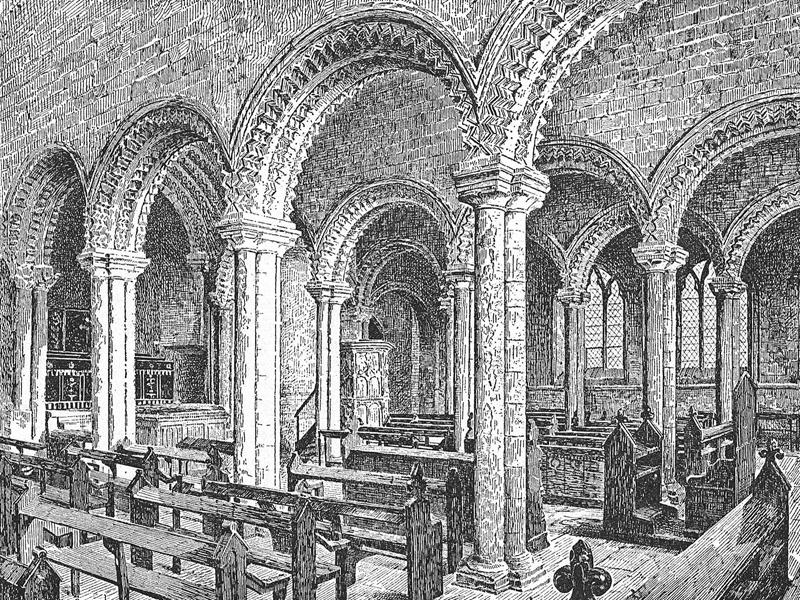
- Expert lecturer
- Practicalities
- Testimonials
This is an architectural journey that would be hard to equal for intensity of aesthetic delight and as a way into the minds and lives of the people of the Middle Ages it would be difficult to surpass. Personalities of extraordinary capability and vision will be discovered, and the thought processes and techniques used by craftsmen of genius revealed and decoded.
The tour ranges across England – north, south, east and west – to see some of the most glorious medieval architecture to be found anywhere. Connoisseurs may carp at the omissions, but logistics exclude only a couple of cathedrals of comparable beauty, magnificence and interest. With an average of little over one cathedral a day, there is plenty of time to really get to know, assimilate, appreciate and contemplate each one.
All but one are medieval, Norman (as Romanesque is generally called in Britain) and Gothic. It is easy to underestimate the length of time the Middle Ages encompasses: the span from the earliest work we see on the tour to the latest, from the Norman Conquest to the Reformation, equals that from the Reformation to the present day. There was huge variety in the building arts and historical circumstances during those 460 years. The one non-medieval cathedral on the itinerary is Coventry. Rebuilt after the Second World War, not only is it a treasure house of mid-twentieth-century art but it is a moving monument to rebirth and reconciliation.
There are many special arrangements to enable you to see more than most visitors and there are opportunities to hear some excellent choirs at Evensong. Cathedrals come with cities, and many of these were relatively little changed during the era of industrialisation and now rank among the loveliest in England. Much beautiful countryside is traversed as well.
Ely. The coach leaves King’s Cross, London at 9.30am for Ely, a surprisingly remote and rural location for one of England’s greatest cathedrals. The mighty Norman nave and transepts (c. 1110–30), with their thick walls, tiers of arches and clusters of shafts, leads to the crossing and its unique 14th-century octagonal lantern, a work of genius. The detached Lady Chapel, also in the Decorated style, is the largest and perhaps the finest in the country; the Early English quire a ravishing setting for the lost shrine to St Etheldreda. Overnight Lincoln.
Lincoln. Also largely by-passed by modern urban development, Lincoln’s hilltop site above the broad Witham valley renders this enormous cathedral even more imposing. Largely rebuilt from 1192, it has always been revered as one of the finest of Gothic cathedrals, its fascinations enhanced by myriad minor inconsistencies and variations which reveal the struggle for solutions at the frontiers of artistic fashion and technological capability. The steep streets of the ancient town are a delight. First of three nights in York.
Durham. Massive towers rise above the trees which cling to the steep embankment, a defensible bulwark in the frequently hostile North. Largely completed in the decades from 1093 and little altered since, the nave and quire with their great cylindrical pillars, distinguished by their engraved patterns, constitute one of the world’s greatest Romanesque churches.
York. York Minster is the largest of English medieval cathedrals. Above ground it is all Gothic, from Early English to Perpendicular but predominantly 14th-century, demonstrating an exceptional knowledge of the latest French Rayonnant ideas. It is a treasure trove of original stained glass, and the polygonal chapter house is without peer. The city retains its medieval walls and an exceptional quantity of historic buildings.
Coventry. Coventry Cathedral is perhaps internationally Britain’s best-known 20th-century building. Built to designs by Sir Basil Spence beside the ruins of its predecessor, destroyed in 1940, it is both a showcase for some of the best art of the time (Graham Sutherland, John Piper, Jacob Epstein). In the evening, a walk through Stratford-upon-Avon, which has retained many buildings Shakespeare would have known. Overnight Stratford.
Gloucester, Bristol. The procession of tall cylindrical pillars in Gloucester’s nave is unadulterated Norman, but, following the burial of Edward II in 1327, the eastern parts are exquisitely veiled in the first large-scale appearance of Perpendicular architecture. The east window, which retains its medieval stained glass, is one of the largest in Europe. Bristol cathedral is a much-overlooked gem with fine work of every era, from the lavishly patterned walls of the Romanesque chapter house to G. E. Street’s great Victorian nave. But its highlight is the east end, among the most innovative and beautiful of early 14th-century buildings. First of two nights in Wells.
Wells. An exceptionally unspoilt little city, Wells has a fortified bishop’s palace, 14th-century houses of the Vicars Choral and much else of charm and interest. The cathedral was one of the first in England to be built entirely in Gothic style. Its screened west front, eastward march of the nave, sequence of experimental contrasted spaces of the Decorated east end, serene chapter house and Perpendicular cloisters all contribute to the cathedral’s exceptional allure. The strainer arches supporting the sagging tower are among the great creations of the Middle Ages.
In 2024: Salisbury. One of the most uplifting experiences in English architecture, Salisbury is unique among the Gothic cathedrals in England in that it was built on a virgin site and largely in a single campaign, 1220–58. To homogeneity are added lucidity of design and perfection of detail. Completed a century later, the spire at 404 feet is the tallest medieval structure in Britain. The close is the finest in the country, and the town beyond has an extensive expanse of historic fabric. Overnight Winchester.
In 2025: Old Sarum, Salisbury. Old Sarum is an Iron Age hillfort, though from ad 1066 to c. 1220 it flourished as a Norman stronghold with castle, palace and cathedral. There are fine views across Salisbury, the city which replaced it. One of the most uplifting experiences in English architecture, Salisbury is unique among the Gothic cathedrals in England in that it was built on a virgin site and largely in a single campaign, 1220–58. To homogeneity are added lucidity of design and perfection of detail. Completed a century later, the spire at 404 feet is the tallest medieval structure in Britain. The close is the finest in the country, and the town beyond has an extensive expanse of historic fabric. Overnight Winchester.
Winchester. Winchester Cathedral is one of Europe’s longest churches, reflecting the city’s status intermittently from the 9th to the 17th centuries as a seat of English government. The transepts are unembellished early Norman (1079), raw architecture of brute power, whereas the mighty nave was dressed 300 years later in suave Perpendicular garb. The profusion of chantry chapels constitutes an enchanting collection of Gothic micro-architecture. Wall paintings, floor tiles, the finest 12th-century Bible. Return to Tothill Street in central London by 4.00pm
Dr Hugh Doherty
Lecturer in medieval history at the University of East Anglia. He was taught at the Universities of London, Cambridge, and Oxford, and was a research fellow at Jesus College, Oxford. He specialises in the period, 700–1200, and publishes on western kings, secular élites and their records. He is a keen believer in the value of exploring and understanding the architectural fabric, material culture and landscapes of the past.

Price, per person
In 2024. Two sharing: £3,290. Single occupancy: £3,730.
In 2025 . Two sharing: £3,490. Single occupancy: £3,950.
Hotel accommodation; private coach throughout; breakfasts, 1 lunch and 6 dinners with wine, water, coffee; all admissions and donations; all tips; the services of the lecturer and tour manager.
Accommodation
The Castle Hotel , Lincoln: 4-star historic building close to the cathedral. The Grand , York: the former headquarters of North Eastern Railway, the hotel retains many original features. The Arden Hotel , Stratford-upon-Avon: a comfortable, 4-star, waterside hotel situated opposite the RSC theatres. The Swan , Wells: 3-star, in a building of 15th-cent. origin in a narrow street close to the cathedral. Hotel du Vin , Winchester: a 4-star, 18th-cent. hotel located in the city centre. Rooms at all the hotels, being city-centre historic properties, vary in size and outlook. Single rooms are doubles for sole use throughout.
How strenuous?
There is quite a lot of walking on the tour. You ought to be able to walk at about three miles an hour for up to half an hour. There are also a lot of steps and uneven surfaces. Roof and tower visits are optional of course, but at Salisbury there are 332 stairs to climb. Four out of the five hotels do not have lifts. Average distance by coach per day: c. 73 miles.
Are you fit enough to join the tour?
Between 10 and 22 participants.
Combine with
In September 2024:
Civilisations of Sicily , 9–21 September
Albania: Crossroads of Antiquity, 11–20 September
Morocco , 11–22 April
West Coast Architecture, 13–23 September
Gastronomic Emilia-Romagna , 14–20 September
Dark Age Brilliance , 15–22 September
Ancient Rome , 16–21 September
Walking a Royal River , 16–22 September
Footpaths of Umbria , 16–23 September
Historic Musical Instruments , 17–20 September
In October 2024:
Courts of Northern Italy , 4–11 October
Basilicata & Calabria , 4–12 October
Malta: prehistoric to present, 7–13 October
The Douro , 8–15 October 2024
Gardens & Villas of the Italian Lakes , 10–16 October
Gastronomic Puglia , 10–16 October 2024
Berlin, Potsdam, Dresden , 10–18 October
In April/May 2025:
Val D’Orcia and the Sienese Hills, 10–16 April
Courts of Northern Italy , 2–9 May
The Ligurian Coast , 3–9 May
Istanbul Revealed , 4–11 May
Palladian Villas , 6–11 May
Walking the Rhine Valley , 7–14 May
Aragón: Hidden Spain , 7–15 May
Music along the Rhine , 8–15 May
In September/October 2025:
Cave Art of France , 3–10 September
Samarkand & Silk Road Cities , 4–16 September
Frank Lloyd Wright, 5–15 September
Courts of Northern Italy , 5–12 September
Classical Greece , 6–15 September
Parma & Bologna , 10–17 September
Essential Andalucía , 29 September–9 October
Gardens & Villas of the Italian Lakes , 2–8 October
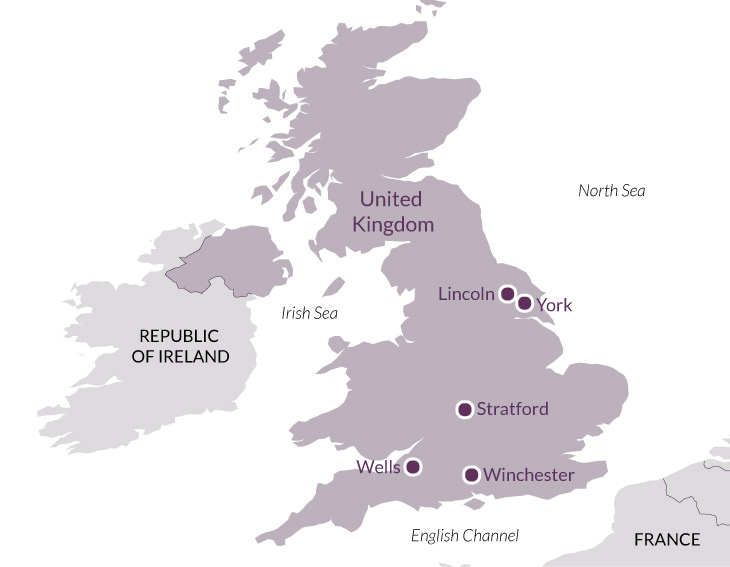
'The lecturer was excellently prepared and communicated vast learning with charm and a light touch.'
'The itinerary was enriching. The whole experience was rich and coherent.'
'This was my first experience with Martin Randall. You met and exceeded all my expectations. I could not have been more pleased.'
'The lecturer was an unbelievably knowledgeable, enthusiastic and affable tour leader. He was a consummate teacher who made the complexity of the history, geography and structure of the cathedrals both interesting and accessible. We were constantly enthralled.'
You may also be interested in...
Lincolnshire churches major and minor, from cathedral to parish.
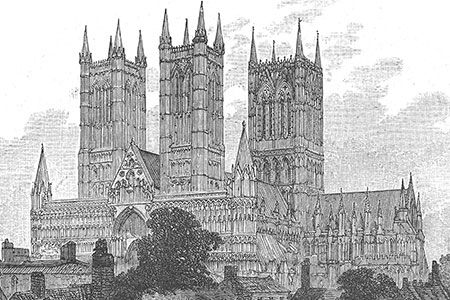
Albania: Crossroads of Antiquity Archaeology, history, art and landscape
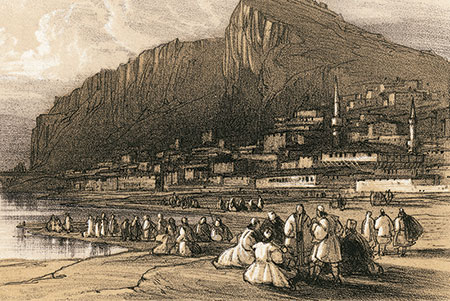
Val D’Orcia and the Sienese Hills lesser-known delights of Southern Tuscany
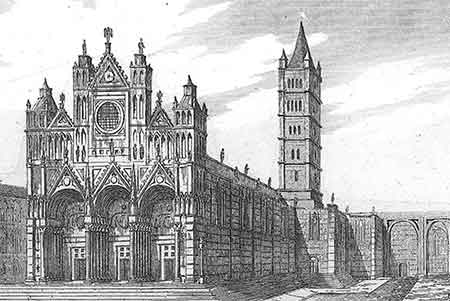
Whitehall Architecture & history
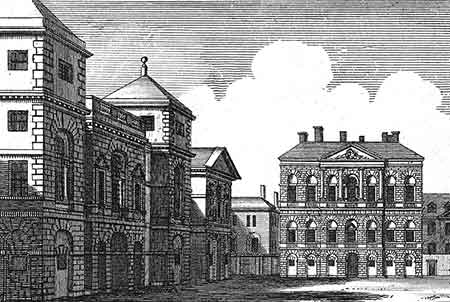
You are using an outdated browser. Please upgrade your browser or activate Google Chrome Frame to improve your experience.

- Mass Livestream
- Museum and Tours
- Hours and Staff
- Parish Life
- Mass & Confession Times
- Adoration & Devotions
- Becoming Catholic
- Sacraments & Other Rites
- Mass Requests
- Parish Events
- Cathedral Concerts
- Communications
- Parish Online Giving
- Light a Candle
- Friends of the Cathedral
- Jubilee Prayer Garden
- Roman Catholic Foundation
- Annual Catholic Appeal
- Cathedral Gala 2024
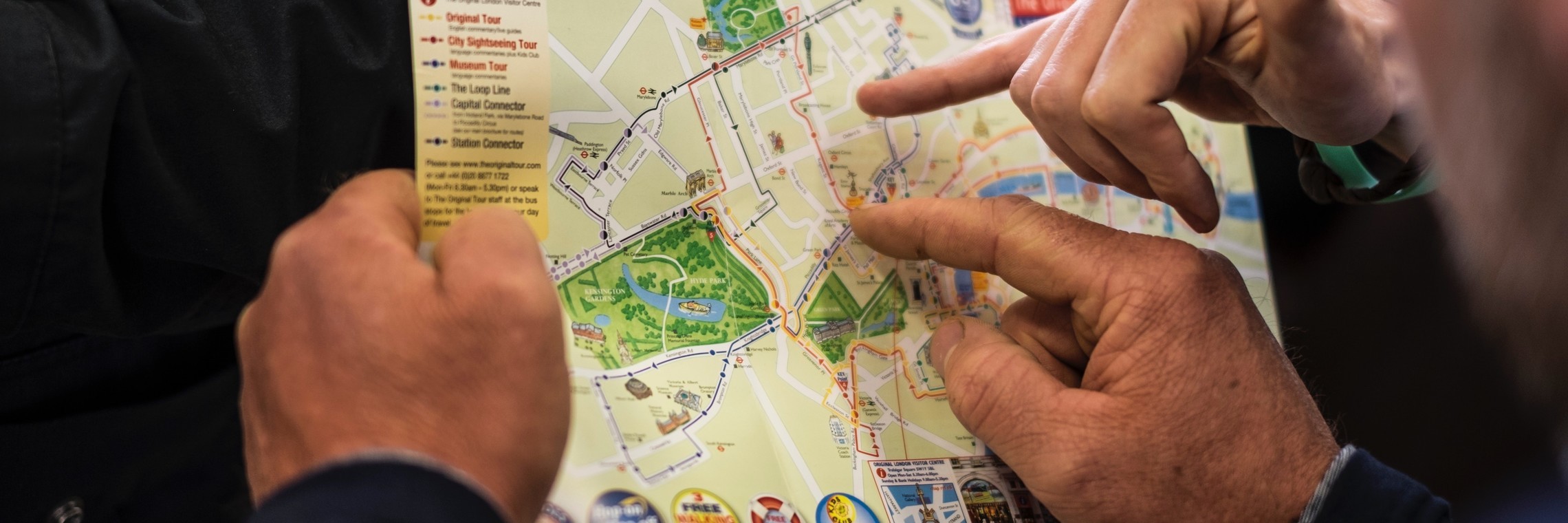
About 10 minutes east of the St. Louis Museum of Art and 12 minutes west of the Gateway Arch. The Cathedral Basilica is a perfect stop for tourists seeking a break from the noise and monotony of the world.
Tour Schedules & Reservations
The Cathedral Basilica is open from 7:00 am – 5:00 pm
Self-guided tours do not require reservations, however, we strongly encourage visitors to call and ensure the church is available, especially on the weekends, due to weddings, funerals, Archdiocesan events, and other weekend activities.
Guided tours, which were suspended in 2020 due to the pandemic, are slowly returning and are available by appointment only. Guided tours are typically available during weekdays between 10:00 a.m.- 3:00 p.m., pending other scheduled events. Please contact the tour office at 314-373-8241 for availability.
We also host a tour on most Sundays following the completion of the noon Mass. The Sunday Tours are open to the public and do not require reservations unless you are bringing in a large group.
Use the form below or call Monday-Friday from 8:30 a.m. – 3:00 p.m. to make a reservation.
All tour inquiries/requests will responded to by the next business day.
314-373-8241
Tour Policies
We ask that visitors who are not participating in Mass wait to visit the Cathedral Basilica until the completion of daily Mass.
Daily Masses are celebrated Monday – Friday at 7:00 am, 8:00 am, and 12:05 pm and Saturday at 8:00 a.m.
Sunday Masses are celebrated at 8:00 a.m., 10:00 a.m., 12:00 p.m., and 5:00 p.m. with a vigil Mass at 5:00 p.m. on Saturday.
Tour Inquiry

A Tour of France's Best Cathedrals
Mary Anne Evans
France boasts some of the world's most ancient, stunning and captivating cathedrals. Each one is a work of art and has its own personality, marked by exquisite carvings and spires reaching to the sky.
Follow this suggested itinerary for your own tour of France's best cathedrals, which stops in Paris, Amiens, Laon, Rouen, Reims, Chartres and Strasbourg. Along the way, you'll also see a tapestry of France's big cities and beautiful villages. You'll get a chance to sample French regional cuisines. You can take in the whole tour, or just do a few of these cities. If your time is very short, just pick one of them. But they are concentrated in the north of France, so it is possible to visit them all in a few days.
If you are taking a car, check out the car hire companies. If you are in the country for 21 days, it's well worth looking at the Renault Eurodrive Buy Back Car Leasing scheme for great value.
Consider using a French Rail Pass . Since your trip will span longish distances in France, this is sure to be a bargain over point-to-point tickets. You can also consider getting a Rail 'n Drive pass, which will provide vouchers for car rentals.
Since you will be moving around a lot (and probably dragging your luggage in and out of train stations), be sure you pack light .
Be sure to have a good road map. You can also tailor make your itinerary with ViaMichelin. Put in your starting point and destination and it comes up with detailed maps of several routes, and includes journey time, distance and costs.
Cathedral Tour Stop One: Notre-Dame de Paris
Notre-Dame de Paris is probably the world's most famous cathedral; it features in everything from classic books to modern-day movies. During a visit to Paris, you will probably get a better view of the whole city from the cathedral, rather than from the Eiffel Tower (because the Eiffel Tower is too tall to see details).
The Gothic cathedral dates from the 12th century. Building started in 1160 and was finished in 1345. It was one of the glories of Gothic architecture, its huge flying buttresses holding up the massive structure; the tower is 68 metres (223 feet) high, reaching into the skies and offering that superb view. The tower is best known for its intricate gargoyles, but it has passed into popular legend as the haunt for Victor Hugo's Quasimodo, the Hunchback of Notre Dame .
If you visit the cathedral, be sure to hike up the seemingly endless spiral stairs to the top to get a close-up look of those extraordinary gargoyles and a grand view of the city and the Seine River. You can also see the historic hunchback's bell at the top. Outside the cathedral is the markation point from which the distance to all cities in France is measured.
Lodging options
Good hotel choices include the Hotel Notre Dame and Hotel Jeu de Paume, both of which are very close to the cathedral.'
For more information about Paris, see the Paris Travel Guide .
Travel time to next stop: Reims in Champagne
By train: From Paris Gare de l'Est, trains run regularly through the day and take 45 minutes.
By car: Take the autoroute for the quickest journey time, around 1 hr 45 mins. The distance is 145 kms (90 miles); there are tolls on the route.
Be sure to have a good road map. You can also tailor make your itinerary with ViaMichelin. Put in your starting point and destination and it comes up with detailed maps of several routes, and includes journey time, distance and costs.
Cathedral Tour Stop Two: Notre-Dame de Reims
Notre-Dame de Reims (pronounced 'Rance') is another of the great Gothic cathedrals in France. It was the place for the crowning of many dynasties of French monarchs, including that of Charles VII, courtesy of Joan of Arc in 1429.
You enter via the west front with its lovely statues. Some are original; others are in the Palais du Tau, the bishop's palace next door to the cathedral. Inside the building is filled with colours from the stained-glass windows. Go to the east end for a fabulous set of windows by Marc Chagall.
A good central option is the Best Western Hotel de la Paix right in the middle of the town and about a 6-minute walk from the train station. It has a good bar and a swimming pool.
For a real treat, book at the Château des Crayères in a restored 18th-century mansion that belonged to Pommery.
Find out more about Reims
Reims is the capital of Champagne and a lovely city of historic interest.
Guide to Reims
Where to Dine in Reims
Visiting a Champagne house in Reims and the surrounding countryside
Hidden Treasures of Champagne
How to get from London the UK and Paris to Reims
Reims Tourist Office
Travel time to the next stop: Laon in the Aisne
By train: Direct trains from Reims to Laon take from 40 minutes and depart at regular intervals.
By car: Take the autoroute and the journey will take you around 50 minutes. The distance is 68 kms (42 miles).
Cathedral Tour Stop Four: Notre-Dame de Laon
If you want to see one of the first of the great Gothic cathedrals, go to Laon (pronounced 'Lon'). It's a beautiful cathedral built in the second half of the 12th century. It set the style for many of the cathedrals that followed, including Chartres, Reims and Paris.
It stands high above the countryside inside the fortified walled city , today a jumble of old winding cobbled streets.
If you want to stay in Laon, one of the best choices is La Maison des Trois Rois (The House of the Tjree Kings). This charming bed and breakfast is in an old house, and it's like stepping back to the Middle Ages - with 21st century comforts.
If you want to combine a cathedral tour with a round of golf, try the Hotel du Golfe de l'Ailette. It's in Chamouille, just south of Laon, but you will need a car to get there. Once there, enjoy the sport or sit looking at the lake.
Laon Tourist Office Website (in French)
Travel time to the next stop: Amiens in Picardy
By train: There are no direct trains from Laon to Amiens and if you want to travel by train you will have to go back to Paris. The train from Laon to Paris Gare du Nord takes1 hr 37 minutes and there are regular departures. The train to Amiens also leaves from Gare du Nord and you will have a waiting time of around 51 minutes before the departure for Amiens. From Paris to Amiens takes 1 hr 12 minutes. Total journey time from Laon to Amiens will be from 3 hours 14 minutes.
- Details of how to get to Amiens
By car: Take the autoroute. the journey lasts 1 hr 28 minutes and the distance is 135 kms (83 miles).
Cathedral Tour Stop Three: Notre-Dame d'Amiens in Picardy
L. Rousselin, Amiens Metropole
Ntotre-Dame d'Amiens is the largest Gothic cathedral in the whole of France and quite rightly one of the UNESCO World Heritage Sites of France . It's also an architecturally important building for its harmony of style. Unlike many cathedrals that took centuries to build, Amiens was constructed between 1220 and 1288. Don't miss the sound and light show in the summer and at Christmas, when the facade comes alive with glorious vibrant shapes and colours. Climb the tower for a great view.
For a taste of the past, book at the charming Le Prieuré, located in a former priory. It's beautiful and stylish.
An excellent modern choice is the centrally located Mercure Amiens Cathedrale, just opposite the cathedral.
More about Amiens
Top Attractions and Things to Do in Amiens
Travel time to the next stop: Rouen in Normandy
By train: There is no direct train from Amiens to Rouen so you will have to go via Paris. The journey time from Amiens to Paris takes 1 hr 12 minutes. Then you have to change station to St Lazaire for a train that takes 1 hr 10 minutes. The total journey time is from 3 hrs 37 minutes.
- Details of how to get to Amiens
- Details of how to get to Rouen
By coach: This is the simplest and cheapest option. Take Flixbus from rue Paul Tellier in Amiens to the train station in Rouen. The journey takes 1 hr 40 minutes and costs around $10.
By car: The autoroute option takes from 1 hr 20 minutes and the distance is 145 kms (90 iles). The route has tolls.
Cathedral Tour Stop Five: Notre-Dame de Rouen
Rouen's Notre-Dame cathedral is a Gothic masterpiece, built in the 12th and 13th centuries, then rebuilt in the 15th and 16th centuries. Known for its now glorious white west facade, painted by Monet over 30 times, the interior is just as wonderful where your eye is carried upwards to the soaring columns. Make your way to the ambulatory and crypt where various monarchs lie and where the heart of Richard the Lionheart is buried.
If you can, be there in the evening in summer for a great light show which projects Monet's wonderful paintings onto the actual facade. giant colours, used by Monet onto the images of 28 times, the capital of Normandy, is one of France's oldest cities.
Lodging Options
The top choice is the historic Hotel de Bourgrethoulde, a luxury hotel housed in an ancient building in the centre of town. But the rooms are thoroughly up to date and there's a spa and swimming pool.
The Hotel de la Cathédrale is a pretty hotel in a pedestrianised lane and just beside the cathedral.
Rouen Tourist Office
Travel time to next stop: Chartres in the Loire Valley
By train: Again there are no direct trains from Rouen to Chartres and you will have to change in Paris. You arrrive in Paris St Lazaire and leave from Gare Montparnasse. The train from Rouen to Paris takes 1 hr 10 minutes and the train from Paris to Chartres takes 1 hr 18 minutes.
Details of how to get from Rouen to Paris
Details of how to get from Paris to Chartres
By car: Take the route nationale for the 138 km (85 mile) journey taking around 1 hr 50 minutes.
By bus: autoroute A13 for the quickest journey time, around 1 hr 50 mins to 2 hours. There are tolls on this route.
Cathedral Tour Stop Six: Notre-Dame de Chartres
Notre-Dame de Chartres is one of the must see sights. It's a glorious edifice right in the centre of a town that climbs up from the river. You can see the cathedral from miles around. It's pretty impressive today but to the medieval peasant it must have been nothing short of a miracle.
Its stained glass is one of the wonders of the world, and remarkably intact. Walk around the cathedral and look up to the panels that tell stories long forgotten, and also touch on the medieval trades and guilds of France.
Try the Jehan de Bauce hotel for a comfortable, good value hotel in a historic building near the train station.
Or stay at my favourite bed and breakfast. Run by the friendly, English-speaking Sylvie Menard, Les Conviv'hotes is near the river.
Find out more about Chartres
Chartres is a lovely small city that makes an ideal base for exploring Paris, Versailles or the Loire Valley chateaux.
Travel time to the next stop: Strasbourg in Alsace
By train: My last stop, Strasbourg is in the east so you will have to go via Paris.
Details of how to get from Chartres to Paris
Trains from Paris leave from the Gare de l'Est and the journey takes arund 1 hr 45 minutes.
How to get from Paris to Strasbourg
Inside Toledo Cathedral: Complete Visitor’s Guide
Holy Toledo, does the city of Toledo have a magnificent cathedral! I was bowled over, and I’ve seen some amazing cathedrals in my day.
The cathedral is considered the spiritual heart of Spain. Construction began in 1226 during the reign of King Ferdinand III.
The building was commissioned by Archbishop Rodrigo Jimenez de Rada. He studied theology in Paris where he became familiar with Notre Dame.
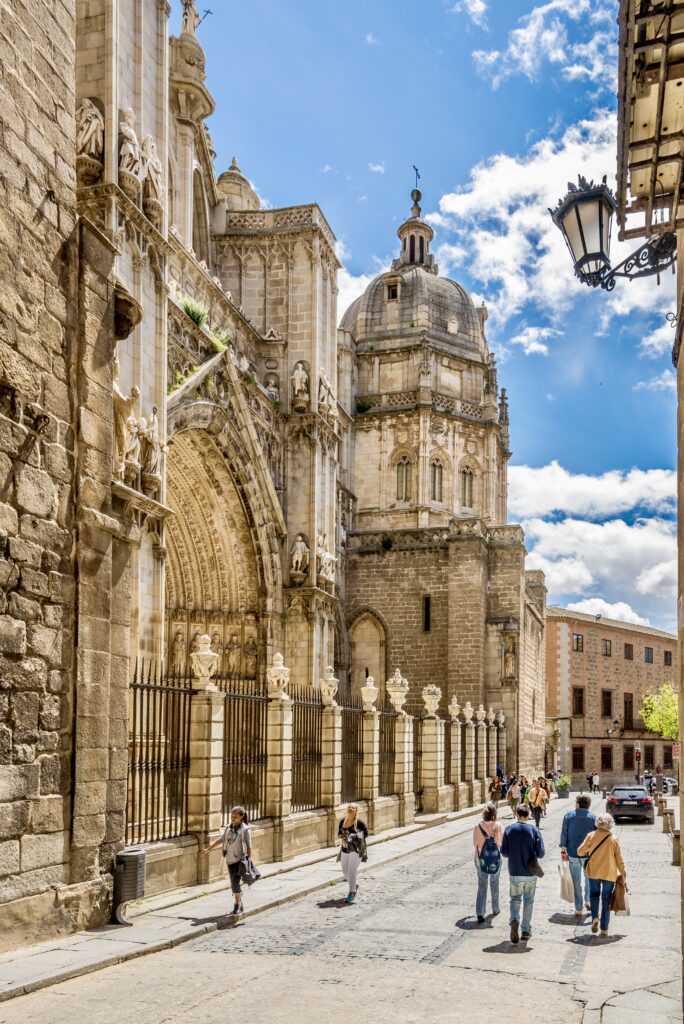
He hired a French architect to design a church that would rival Notre Dame in size and beauty, to become a symbol of the power of the Spanish Catholic church.
Over the centuries, the cathedral was decorated with the sites you will see on a visit — a massive Gothic altarpiece, Renaissance frescos, a masterpiece-filled sacristy, a golden monstrance, 25 chapels, and a one-of-kind skylight.
>>> Click here to book a guided tour of the cathedral
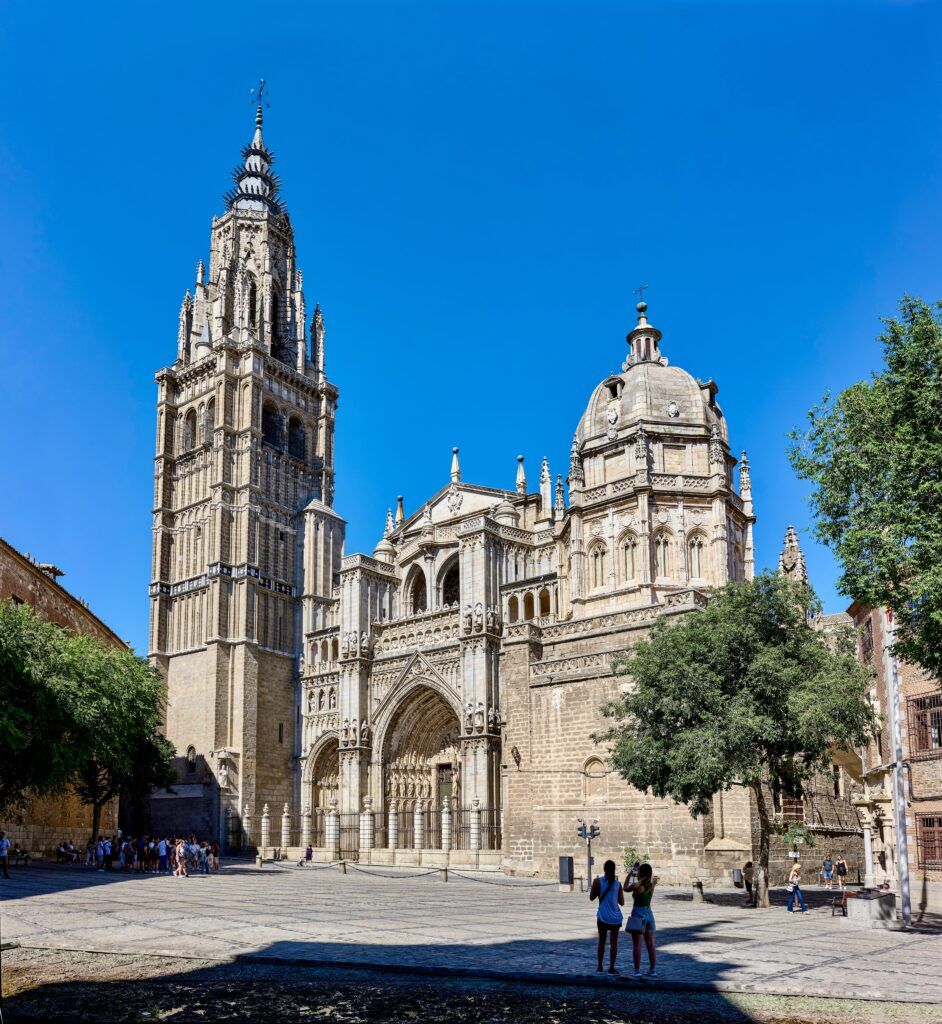
Guide To Toledo Cathedral: What To See
Here are the cathedral’s must see highlights. I’ve listed them in the order it makes sense to visit them after entering the cathedral.
The facade of the cathedral is mainly Gothic. Though not all Gothic. To be truly Gothic, it would need matching spires.
But it only has one. The right side was never completed. Instead, when it was growing unstable, the son of El Greco topped it with a Baroque dome.
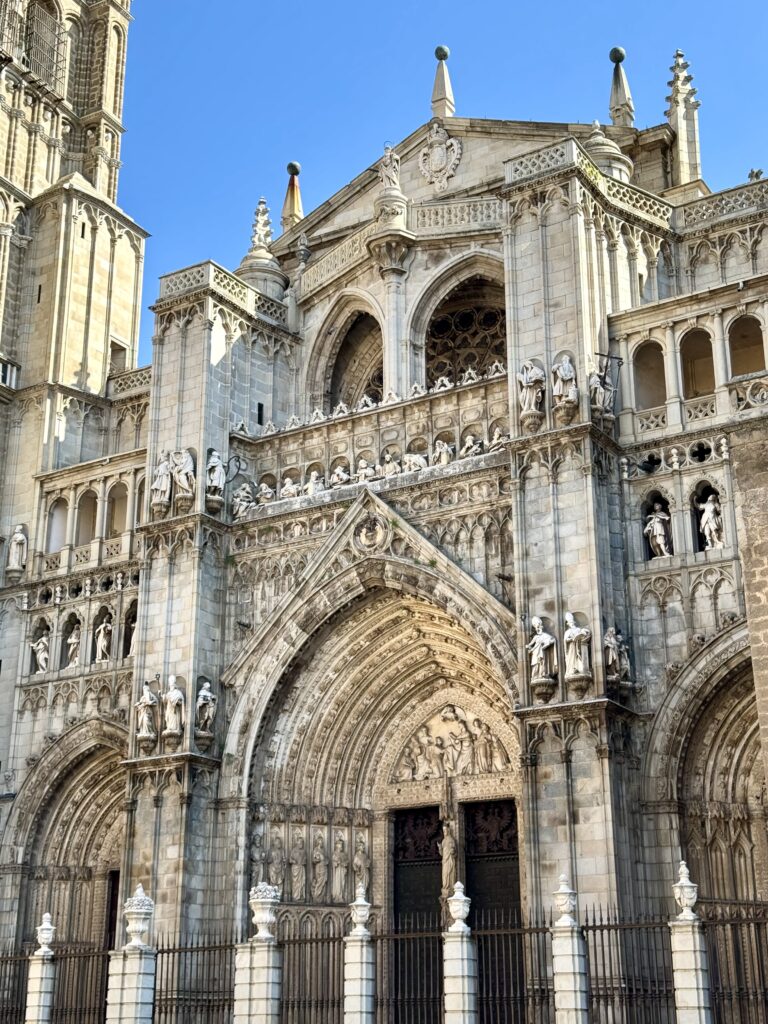
There are three elaborate portals, known as the Gate of Forgiveness, the Gate of Judgment, and the Gate of Hell.
The central portal is the Gate of Forgiveness. It was named for the indulgences granted to those who crossed it. Today, the door is only opened no special occasions for royalty or the pope.
The portals are made of soft yellow limestone. The rest of the cathedral was constructed with gray granite.
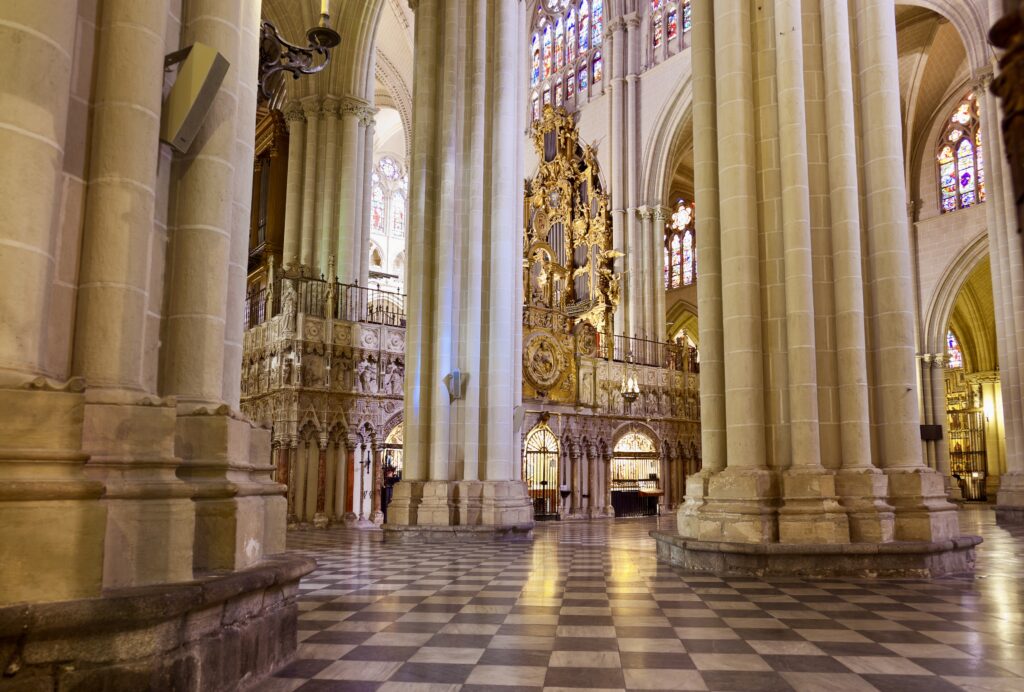
The cathedral interior is Spain’s purest form of Gothic architecture. The nave is over 400 feet long and 200 feet wide. It’s made up of five aisles.
It doesn’t seem quite that long when you first walk in. But that’s because the choir is smack in the middle of the nave.
You’ll find a soaring ribbed vaulted ceiling, 500 year old stained glass windows, ornate wood carvings, statuary, and a forest of stout pillars.
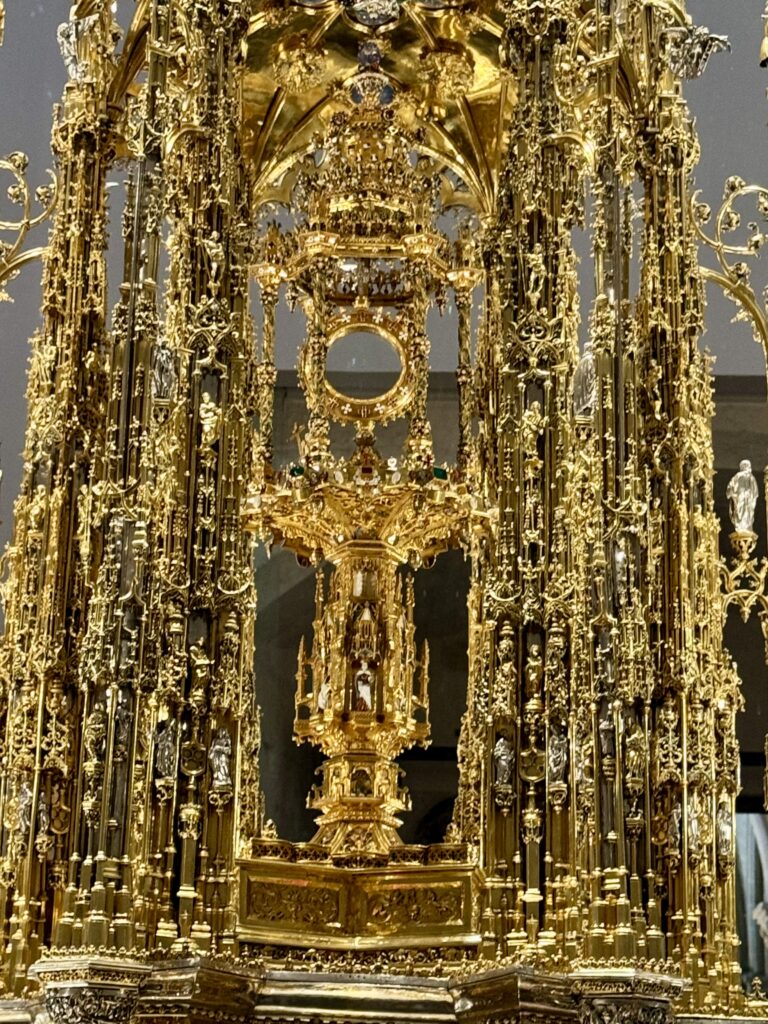
Treasury: Monstrance
The Chapel of the Treasury is a small room located at the base of the bell tower. In the center, you’ll see the star attraction, the Monstrance of Corpus Christi (body of Christ).
The monstrance is a 500 pound, 10 foot Gothic tower. It’s gilded with gold, silver, and precious stones. There are 500 pieces to it, including 250 mini statuettes.
It’s the most important thing in the cathedral. It was made for Queen Isabella and purchased by the cathedral.
The monstrance that holds the host is a smaller portable piece within the shrine. It was designed to hold the Holy Communion wafer.
The monstrance is paraded around town every year during Toledo’s most beloved festival, The Corpus Christi Festival.
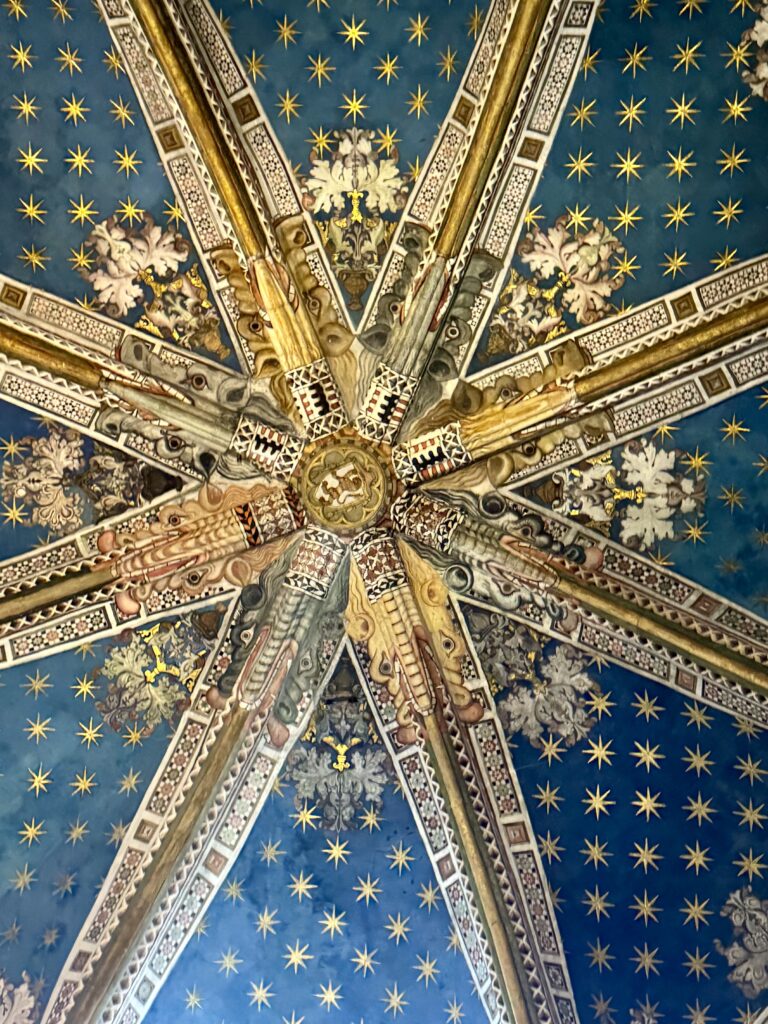
After the treasury, take the door immediately to the left to enter the cloister. It’s worth a visit for its frescos and finely carved colonnade.
The cloister houses late 18th century frescos depicting the life of St. Eugene, the city’s patron saint and the founder of the Toledo Holy See.
The most important thing to see here is the Chapel of San Blas, one of the most beautiful chapels in the cathedral.
It contains a splendid fresco cycle by the Florentine painter Starnina from the second half of the 14th century. Starnina was a pupil of the Italian Renaissance master Giotto .
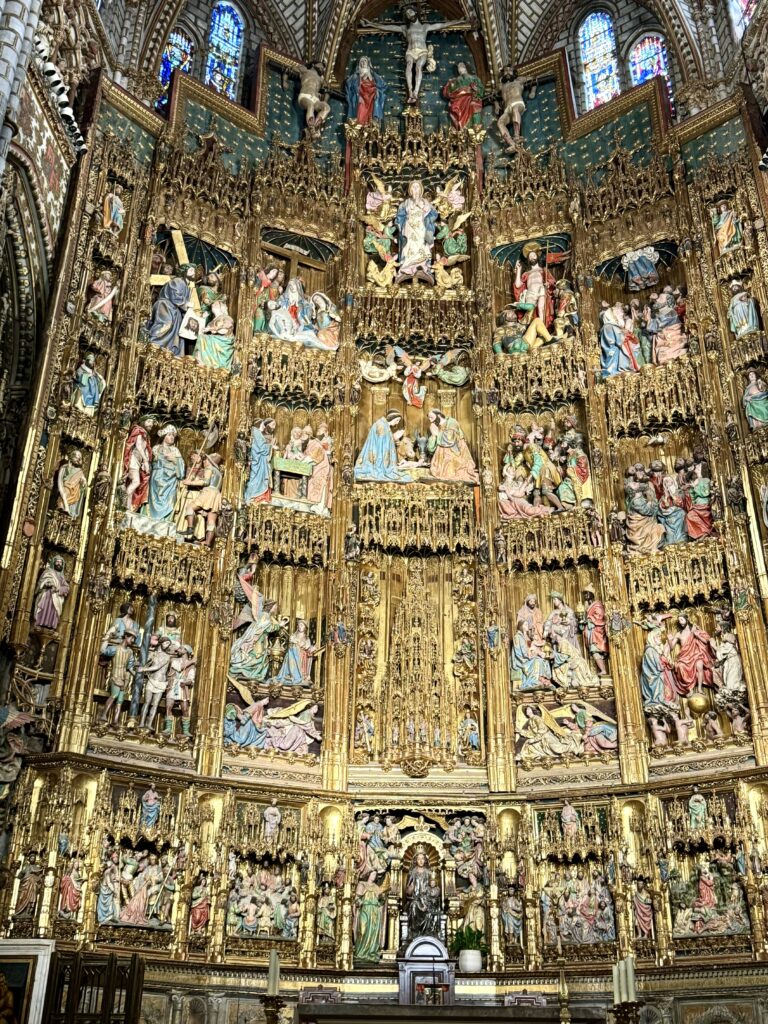
Main Chapel & High Altar
The main chapel is the most sacred part of the Toledo Cathedral. Climb up two steps and grip the iron grill to peer inside. This is where mass is held on Sunday morning.
The grill is a wonderful Renaissance piece by Francisco de Villapando from 1548, considered the best in Spain. It’s made of bronze and brass and plated in gold and silver, though some of the luster has worn off over time.
The altar is one of Spain’s best pieces of Gothic art. It’s a stunning 80 feet high piece made of real gold on wood.
The scenes narrate the life of Jesus, from the annunciation to the resurrection.
To the right of the altar are a row of stone statues of bishops and saints. To the left is the tomb of Cardinal Mendoza, the man who helped Ferdinand and Isabella conquer the Moors and promoted Christopher Columbus.
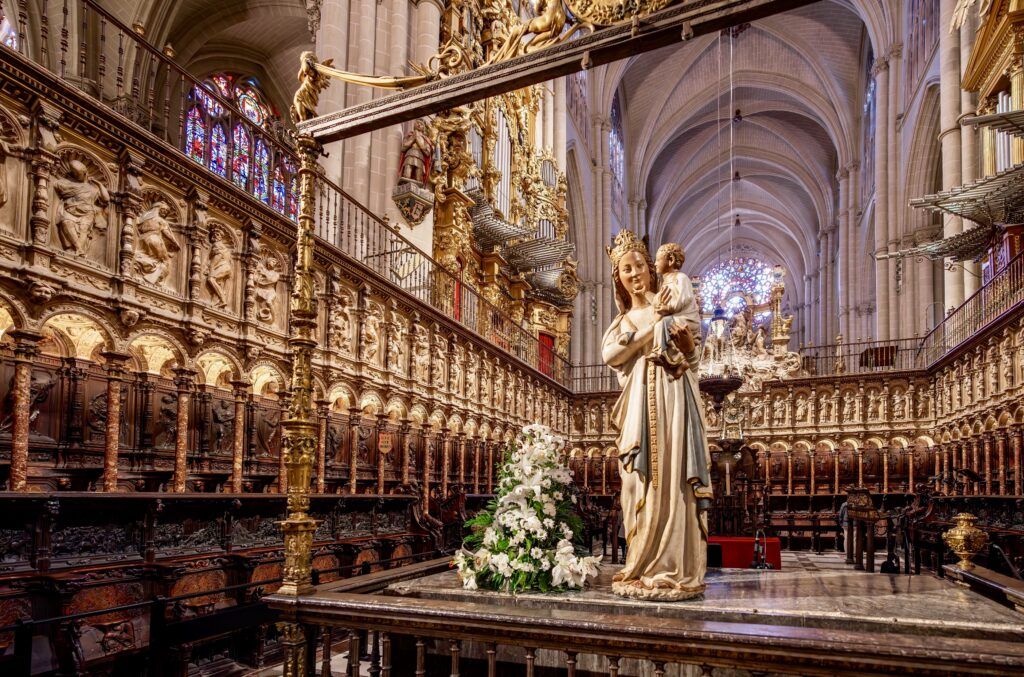
The gorgeous choir was one of my favorite spaces in the cathedral. You’re greeted by a sculpture of the Virgin Mary called the Virgin Blanca .
The intimate space is lined with 120 wood carved stalls. The carvings depict scenes from the Christian Reconquista, specifically the retaking of Granada which marked the end of the 800 year holy war against Muslims.
The seat backs are made of carved walnut and feature New Testament figures. The misericords , or “cheat seats,” allowed tired worshippers to lean back while they stood.
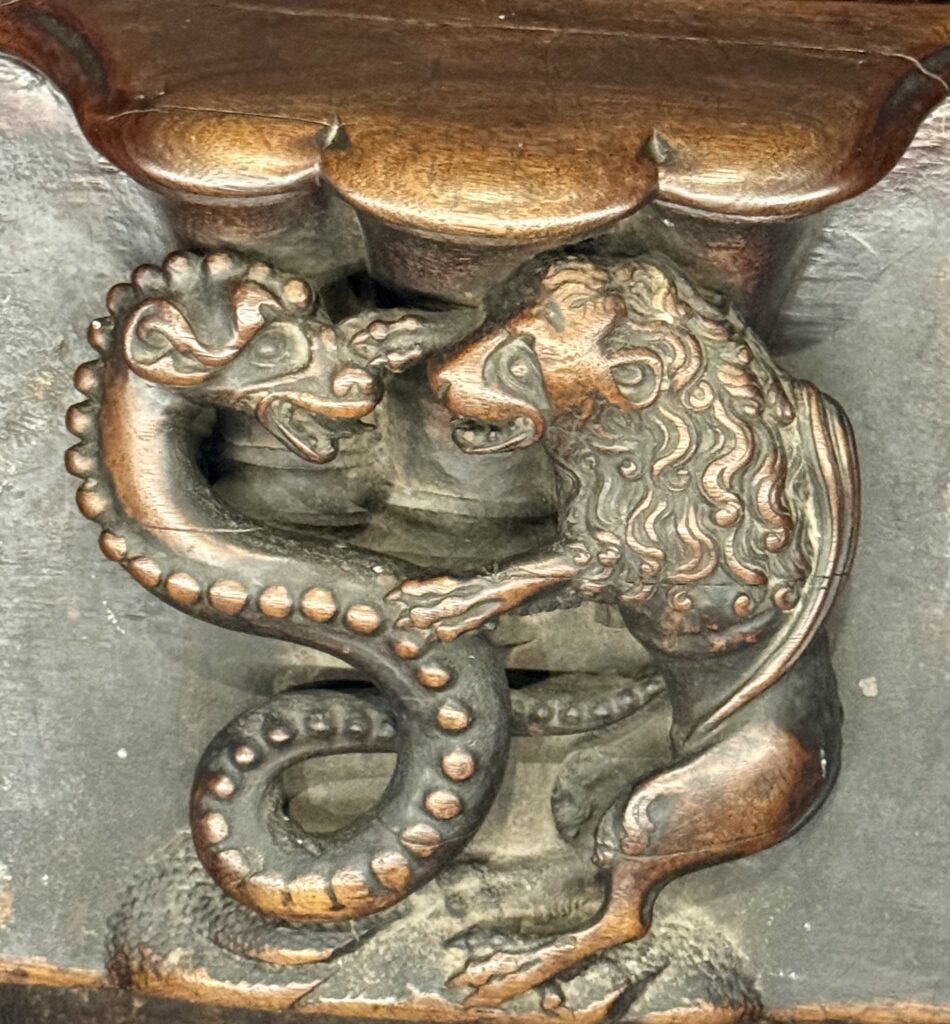
They’re decorated with cute little animals (even erotic scenes!) representing the vices and virtues of mankind.
The choir is also ringed with alabaster stone statues giving you a genealogy of Christ.
And there are two fine organs, each with over 600 pipes. One is Baroque and the other is Neoclassical.
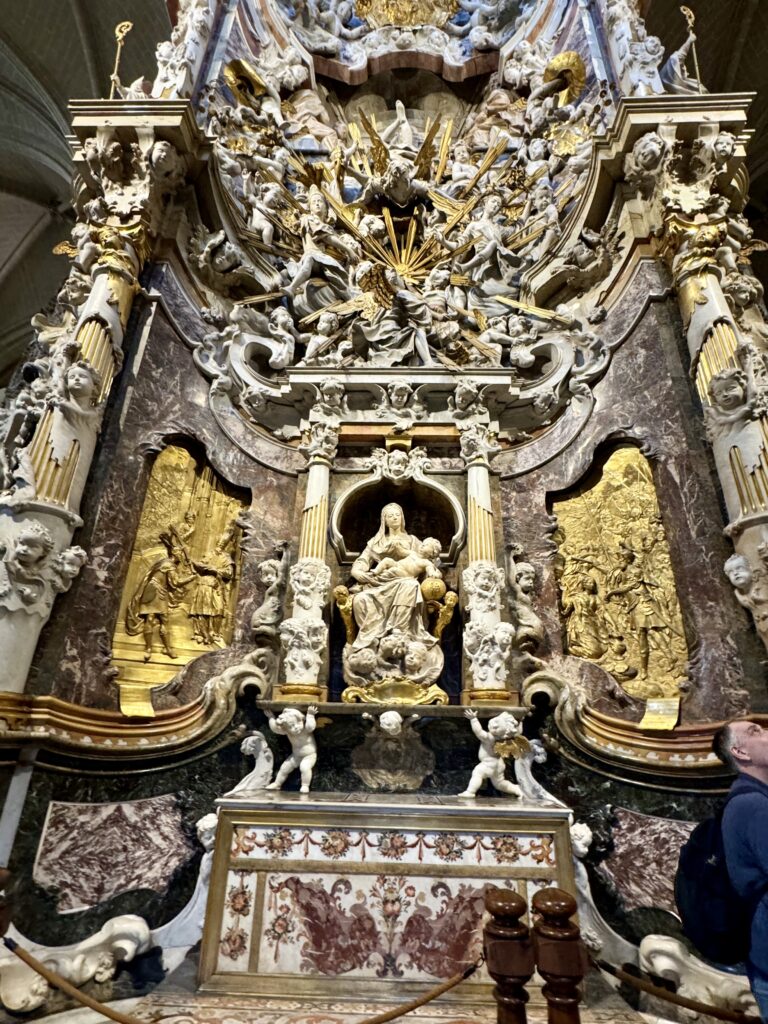
El Transparente
After you pass the main chapel, you will arrive at the cathedral’s Baroque folly, El Transparente . It’s a towering white, red, and gold altarpiece bursting with statuary. This multimedia masterpiece was created by the sculptor Narciso Tome in 1732.
In the 1700s, a skylight was cut in the cathedral ceiling. There are two windows.
The window at the high part of the vault lets in the morning light, sending a beam to light up the sculpture. You can see depictions of prophets in the dome frescos and scenes linked to the Eucharistic the Old Testament.
The second window is at the back of the main chapel. This is where you can see the dynamic marble altarpiece. It shows characters and scenes of the Eucharist from the New Testament.
The altar itself is a monumental structure adorned with marble columns, gilded decorations, and elaborate reliefs.
There’s a riot of angels and cherubs. Baby Jesus points a finger at original sin. At the top is the Last Supper, the climax of the piece.
Chapter House
The Chapter house is directly behind the main chapel on the right. It was built in the early 16th century by Cardinal Cisneros and was used as a meeting hall.
The hall is decorated with frescos by the French artist Jean de Bourgogne. They depict scenes from the life of the Virgin Mary.
There’s a wonderful Last Judgment where people committing the seven sins are cast into hell and the good souls are saved.
Below the frescos are two rows of portraits of the bishops and archbishops of Toledo. The upper row dates from the 16th century and was painted from the imagination (except for the one off Cisneros). The faces all look a bit alike, as if they were recycled by the artists.
The lower portraits were added one at a time from 1515 to the present day. These are genuine portraits painted from life, and hence more interesting.
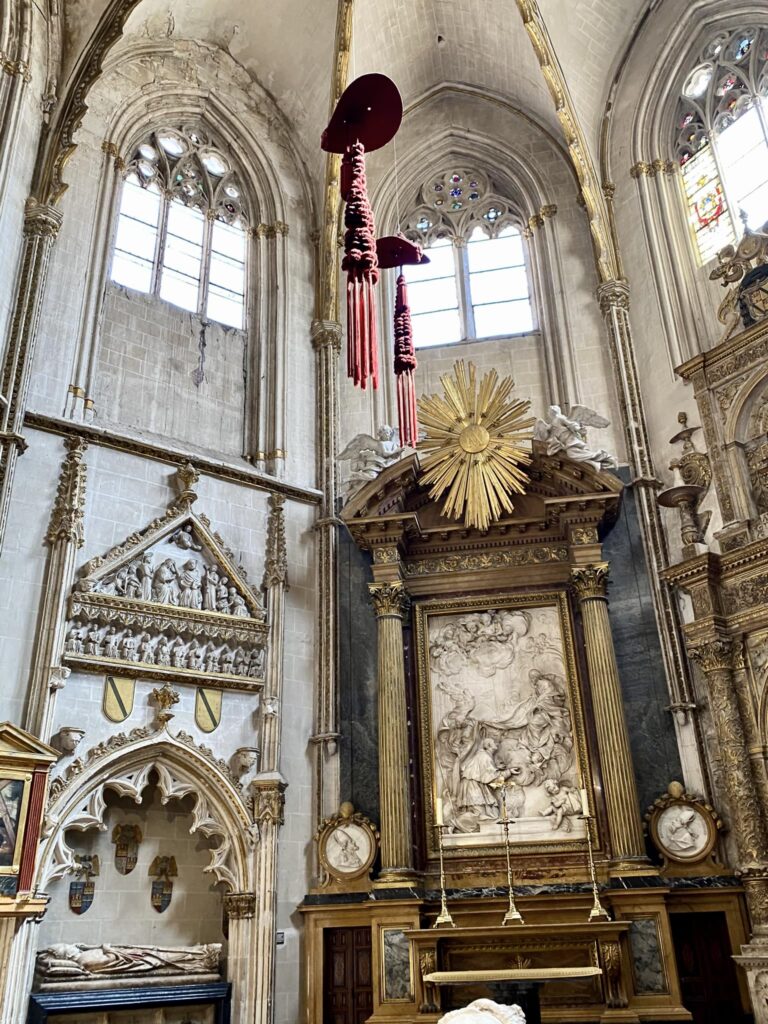
Chapel of St. Idelfonso
The great Chapel of St. Idelfonso is the funery chapel of one of the richest and most powerful families in Castille.
It was commissioned by Gil de Albronoz, Archbishop of Toledo and Cardinal of Spain. Albornoz and much of his family are buried in the side wall niches and underground crypt.
Two cardinal’s hats, known as galeros , hang from the ceiling, indicating a cardinal is buried below. It’s a mark of honor, symbolizing their esteemed position.
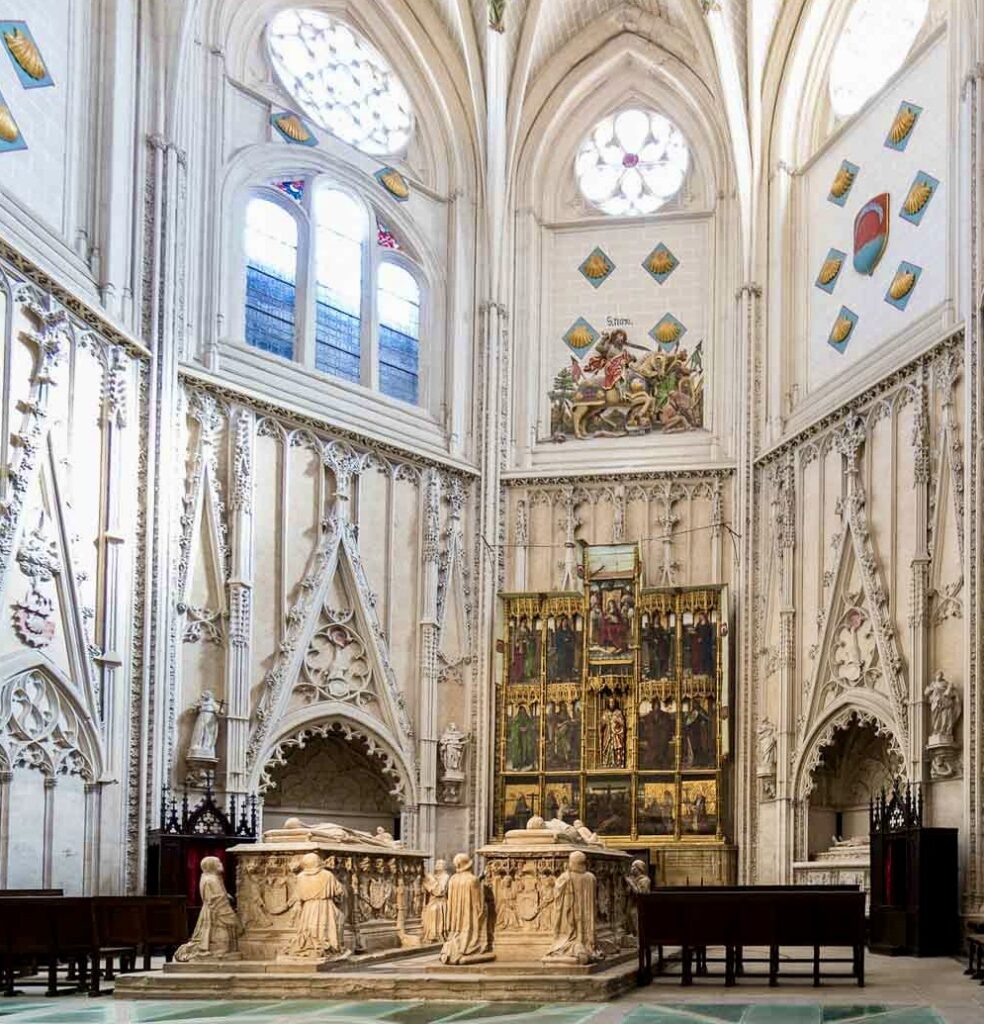
Chapel of St. James
Next door is the chapel of St. James. This is the richest and most luxurious chapel in the cathedral, built in a Flamboyant Gothic style.
Don Albaro de Luna commissioned the chapel in the mid 15th century to be his burial place. Albaro possessed enormous power at the time, and was a favorite of the King of Castille, Isabella’s father.
The central tombs are that of Albaro and his wife. His family is buried in the wall inches.
The Gothic altarpiece is very elaborate. It’s the work of Pedro de Gumiel, with fourteen panels painted by Sancho de Zamora. In the center is the figure of St. James. He’s on horseback killing the Muslims ( a very non PC scene indeed, but historically accurate).
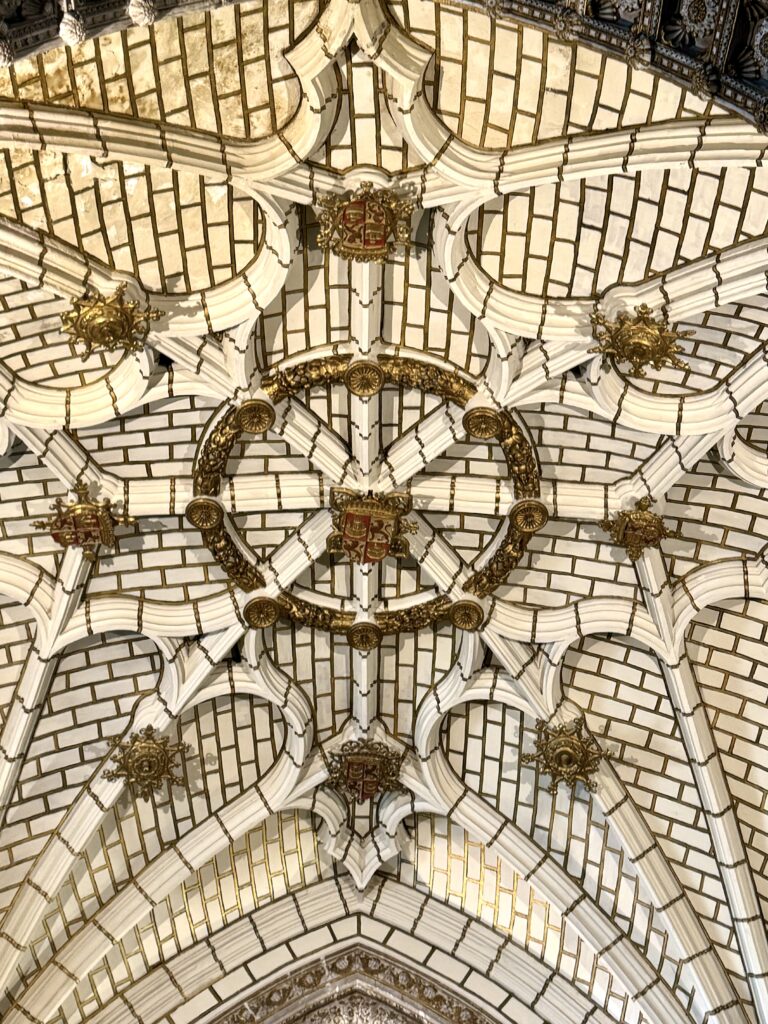
Chapel of the New Kings
This Renaissance style chapel is akin to a mini church. It was commissioned in the mid 16th center by Charles V, grandson of the Catholic monarchs.
It’s the burial place of eight medieval kings of his lineage. Reclining statues mark the tombs. They are depicted in regal attire and surrounded by religious symbols and heraldic motifs.
Among the monarchs buried in the Chapel of the New Kings are King Sancho IV of Castile and his wife Queen María de Molina, as well as their son King Ferdinand IV.
The two sections of the nave have Gothic cross vaults. But all of the ornamentation and carving of the tombs is in Renaissance style.
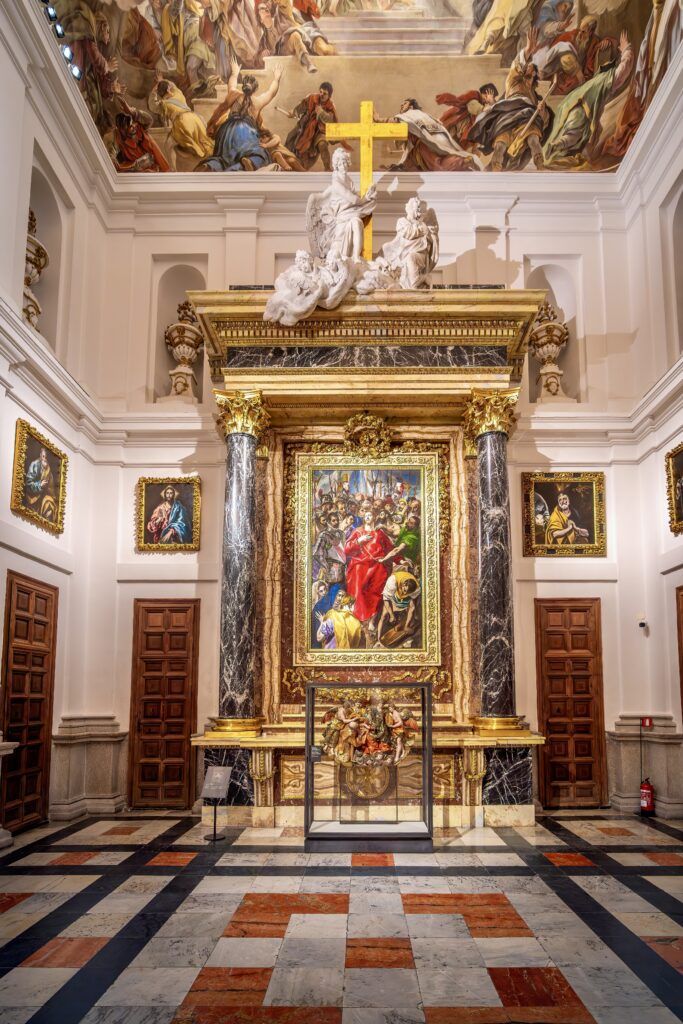
For art lovers, the Sacristy may be the highlight of the cathedral. It was renovated in 2013, giving it an unbeatable new look.
A sacristy is the priest’s locker room. This is where they put on their clerical robes and where objects necessary for religious worship were kept.
This one is a mini-Prado. There are 19 El Greco paintings and works by the likes of Goya, Titian, Velazquez, and Caravaggio. The ceiling fresco is by Luca Giordano and depicts The Descent of the Virgin .
The most important painting in the collection is front and center, El Greco’s The Disrobing of Christ . It was the first masterpiece he painted after arriving in Toledo.
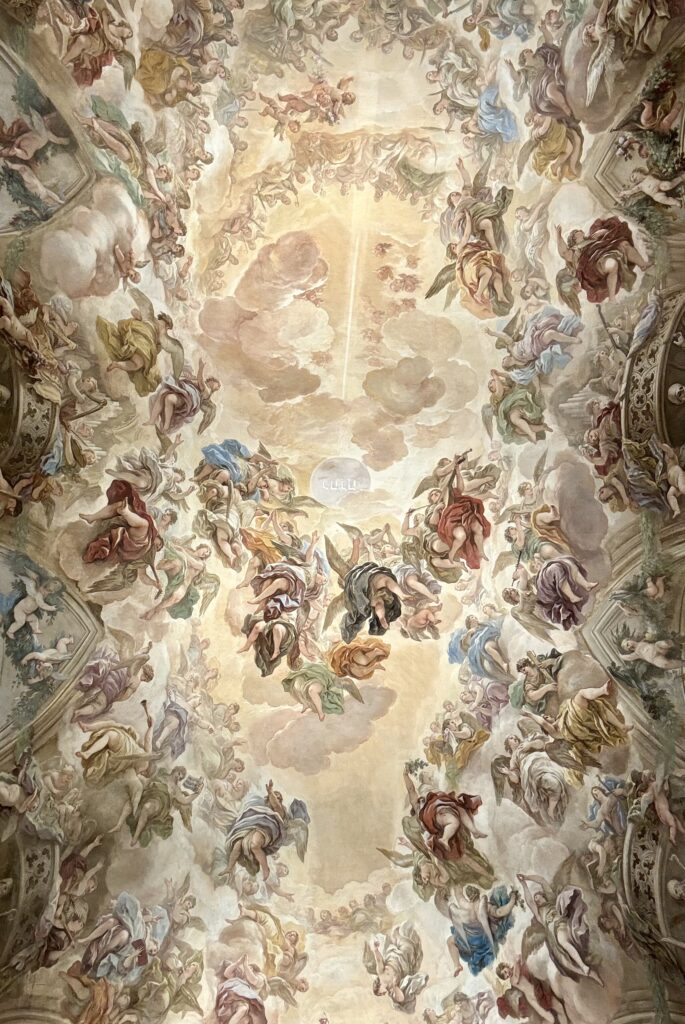
It portrays the moment when Christ is undressed before his crucifixion. He looks dignified, while he endures ignoble treatment from an angry mob.
As in many El Greco paintings, Christ looks like he’s almost levitating. The painting is quite Italian, reflecting El Greco’s stays in Venice and Rome . The bright red robe, a typical Titian color, stands out.
There are other El Grecos adorning the room, including portraits of the apostles.
To the right of the Disrobing is a painting by Goya, the Betrayal of Christ . It shows Judas preparing to kiss Christ, a signal to the Roman soldiers waiting to seize him.
In two adjoining rooms are more masterpieces by artists like Titian, Velazquez, Van Dyke, Raphael, Bellini, Bassano, and Zurburan. Of note is Titian’s probing portrait of Pope Paul III.
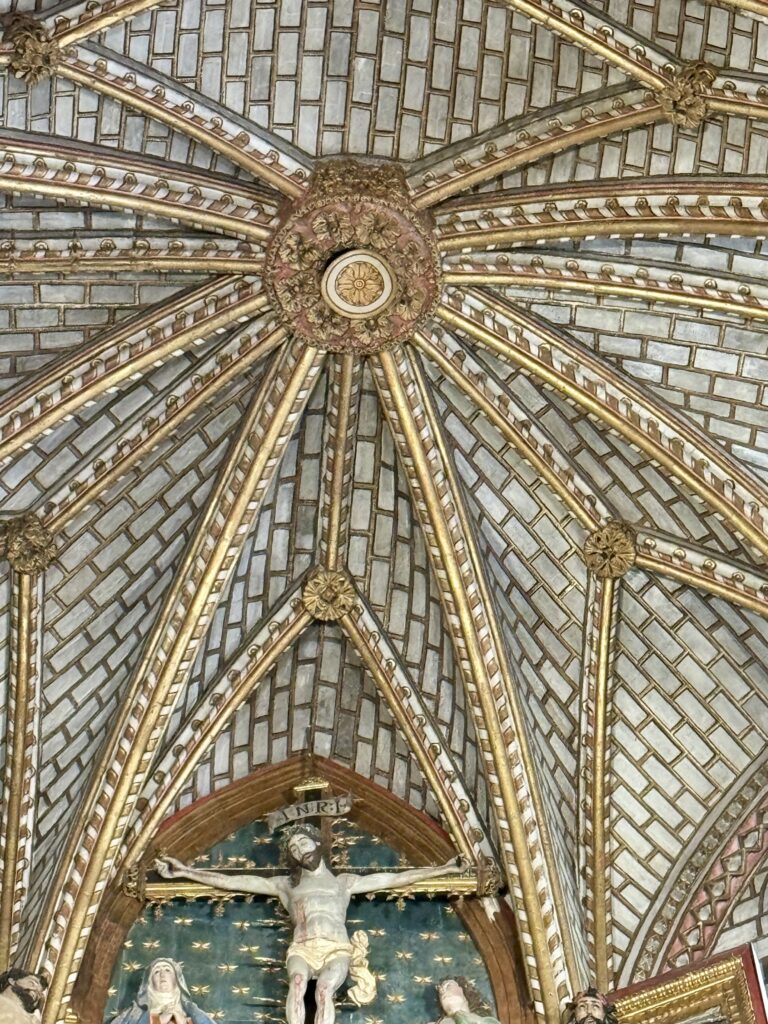
Practical Guide & Tips For Toledo Cathedral
Address : Calle Cardenal Cisneros, 1. The entrance is to the right of the front facade of the cathedral.
Hours : Monday through Saturday from 10:00 am to 6:30 pm. Sundays and holidays from 2:00 pm to 6:30 pm.
Tickets : 12 euros. Tickets are sold in the shop opposite the church entrance. Click here to pre-book a ticket in advance, a good idea in high season.
Remember that Toledo Cathedral is a religious site, so dress modestly out of respect. Avoid wearing clothing that exposes shoulders, knees, or midriffs.
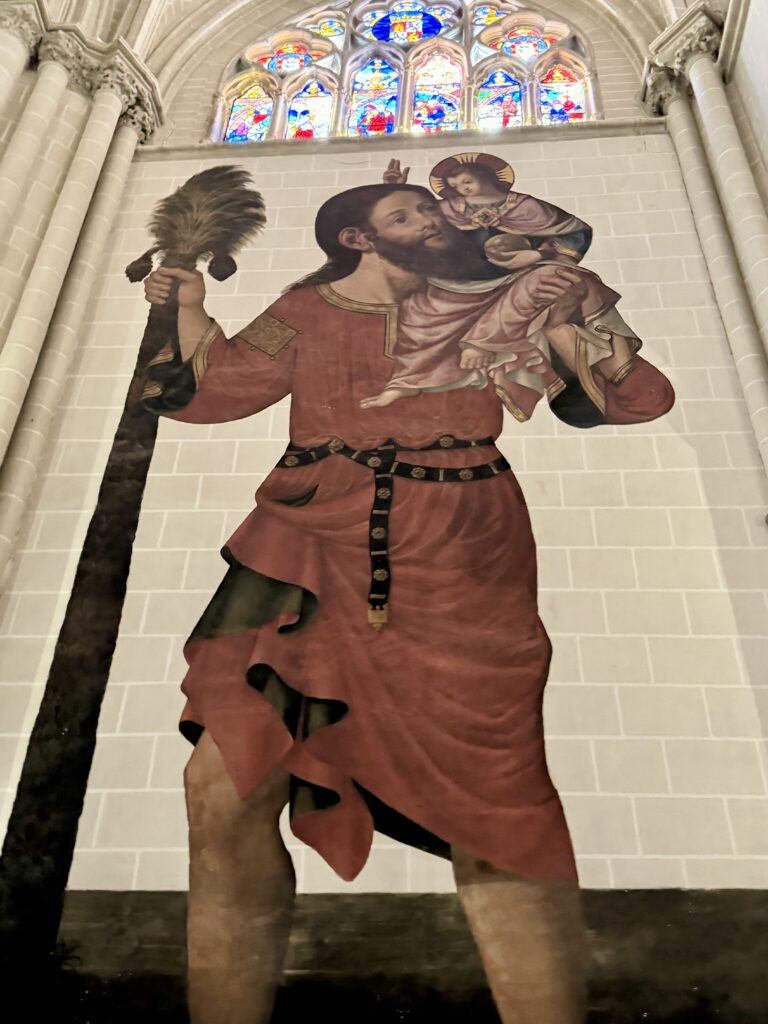
I would budget at least 90 minutes to see everything. 2 hours might be a better estimate, especially if you want to peak at all the chapels.
I hope you’ve enjoyed my guide to Toledo Cathedral. You may enjoy these other Spain travel guides:
- 10-14 days in Spain itinerary
- 3 day itinerary for Barcelona
- 40+ Landmarks in Barcelona
- 33 secret towns in Spain
- 10 day itinerary for Andalusia
- Most Beautiful Towns in Andalusia
- 1 day itinerary for Seville
- 3 day itinerary for Seville
- 2 day itinerary for Madrid
- 2 day Itinerary for Bilbao
Pin it for later.
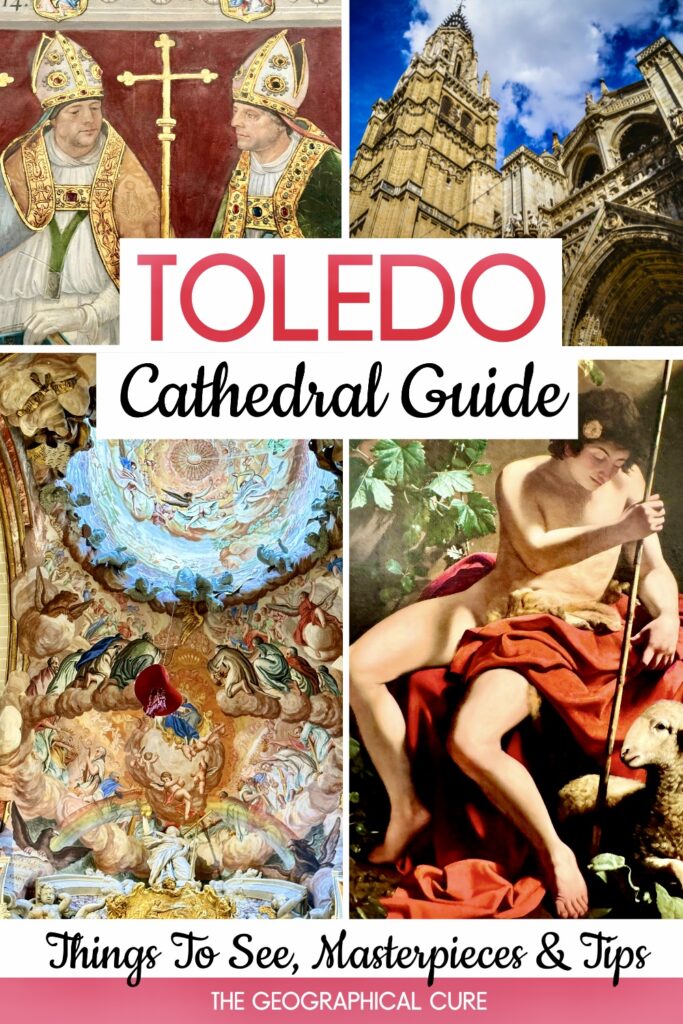
Leave a Comment Cancel reply
Save my name, email, and website in this browser for the next time I comment.
Last Updated on March 20, 2024 by Leslie Livingston

- TripAdvisor
- Testimonials
- Travel Tips
St. Basil's Cathedral
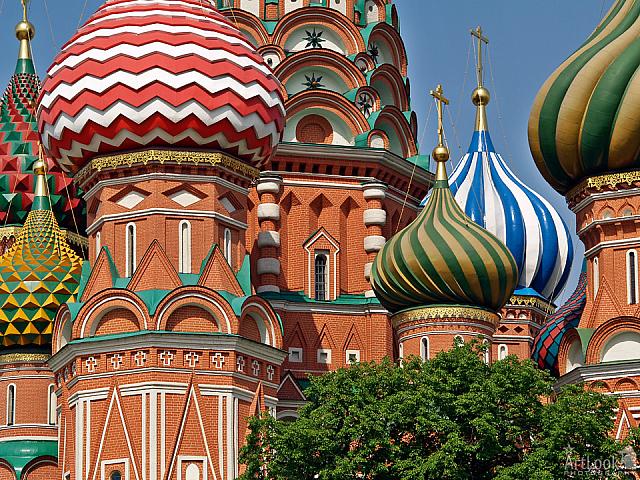
In contrast to its fascinating exterior, the cathedral is disappointingly small inside. There is not enough room for many people to pray at the same time. The cramped rooms, low gallery vaults and narrow passageways seem more appropriate for a Medieval home, not a place of worship. We can assume that the cathedral was originally intended to impress with its exterior appearance only.
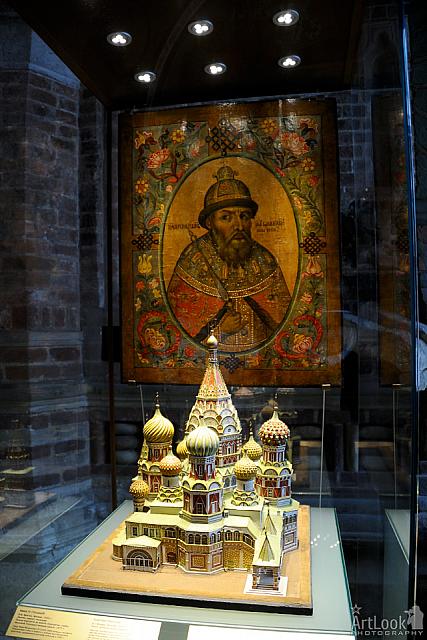
The Battle of Kazan was compared to the Battle of Kulikovo Polye, which had ended centuries of Tartar Mongolian rule in Russia. Upon his return from Kazan, the Czar threw a sumptuous feast in the Kremlin that went on for several days with lavish gifts for everyone.
The original wooden Cathedral of the Intercession of the Holy Virgin with seven Chapels was consecrated on 1 October 1554. Some of the Chapels were dedicated to the saints whose holidays had coincided with Kazan campaign highlights: August 30 (according to the old calendar), when the Russians had defeated a large Tartar troop led by Prince Epancha, is the day of three Constantinople Patriarchs: Alexander, John and Paul, as well as St. Alexander of Svir. On September 30, the day dedicated to Gregory, the enlightener of Armenia, the Russians had captured a part of the Kazan fortress wall and the Arsk tower. Kazan was stormed and conquered on October 2, Sts. Cyprian and Justina Day These dedication and the choice of location for the new temple continued a tradition started by Vasily III, Ivan the Terrible’s father, who had ordered a Cathedral built by the moat to commemorate his conquest of Smolensk, dedicating its altars to the saints whose name days coincided with the day of his victory over Smolensk. The older church had burned down during one of Moscow’s many fires.
Another altar in the new Cathedral was consecrated in honor of St. Varlaam of Khutyn, possibly in memory of Vasily III who had, at the end of his life, taken monastic vows as was the custom for Russian rulers at the time. Basil’s monastic name was Varlaam. The altar in the easterly Chapel was dedicated to the Holy Trinity, while the main altar was dedicated to the Holy Virgin’s patronage over all Christians. Virgin Mary is specially worshipped in the Russian Orthodox tradition as a celestial protector. On Intercession of the Holy Virgin Day, Kazan had stood besieged, and soon fell. The westerly Chapel was dedicated to the Entry of Jesus into Jerusalem. This holiday was marked with a “donkey procession” (described in the Red Square chapter). Before the Cathedral of the Intercession was built, the procession had always stayed inside the Kremlin walls. It is possible that the Czar had had a change of the procession itinerary in mind when he ordered the Cathedral built. From then on, the procession would walk from the Kremlin to the new temple.
Ivan the Terrible soon ordered the Cathedral rebuilt in stone. According to historical evidence, the architects “Barma and Postnik Yakovlev,” hired to design the stone Cathedral, had originally designed it with nine altars, and here is why.Soon before the construction began, the Czar had received visitors from the town of Khlynov (Viatka), bringing the tidings of a new miracle-working icon of St. Nicholas Velikoretsky. The icon had survived a devastating church fire with only minor damage, and the envoys from Viatka were seeking the Czar’s permission to bring it to Moscow for restoration. The Czar had prayed to St. Nicholas repeatedly during his Kazan campaign, so the appearance of a new miraculous St. Nicholas icon was conceived as the saint’s blessing for what the Czar had done, instituting Orthodox Christianity in the Kazan lands and annexing them to Muscovy. Ivan the Terrible ordered the icon delivered to Moscow immediately, and decided to dedicate the ninth Chapel of his new Cathedral to St. Nicholas. The icon was shipped by riverboat across the Kazan lands as a semblance of the Procession of the Cross across the previously pagan Tartar Khanate, now conquered by Russia.
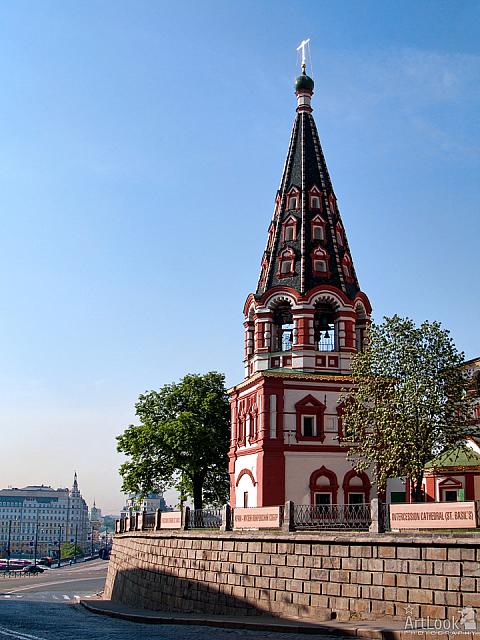
In 1588, during the reign of Feodor, another church was built here on the grave of Basil the Blessed, a street prophet worshipped in Moscow at the time, who had died in 1557. Unlike the other Chapels of the Cathedral of the Intercession, this church held daily sermons, so it wasn’t long before parishioners started calling the whole-cathedral St. Basil’s.
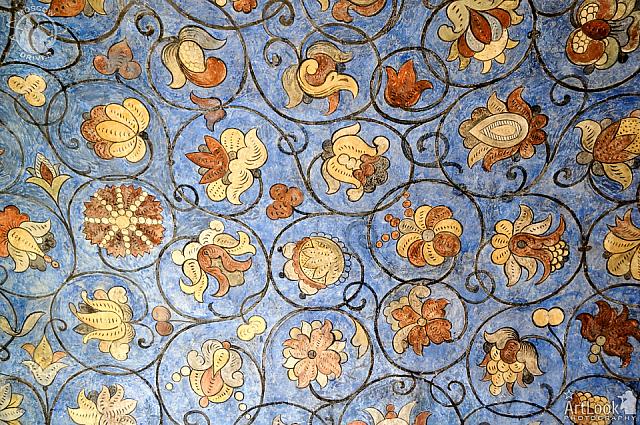
Many of the “guest” altars were “retired” during the reign of Catherine II in the 18th century, and the Cathedral was repainted according to the artistic fashion of the epoch.
The cathedral acquired its present colorful look after a succession of restorations in the 20thcentury, which restored the temple to its 16th-17th century look. The motley onion domes were painted the way they were in the 19th century.
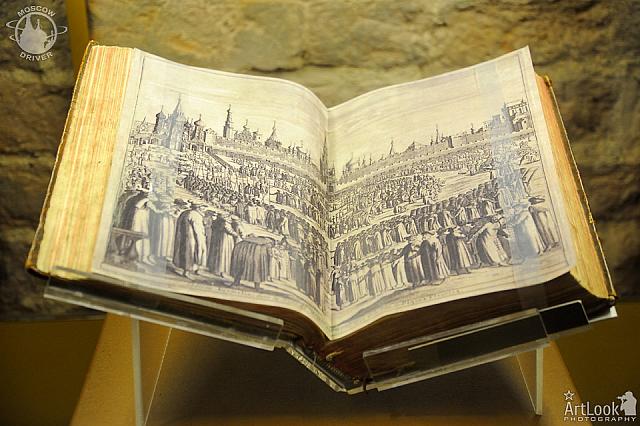
Holy Relics at St. Basil’s
A Moscow street prophet, Basil the Blessed, was buried by the Cathedral’s northeastern wall in 1557. According to legend, Basil was revered and feared by Ivan the Terrible himself as a Holy Fool (Yourodivy).
Such person was someone who had voluntarily rejected earthly comforts and pleasures. Under the guise of insanity, these people defied all shame and decency. (Usually, these “God’s Fools” were quite sane, sensible — or at least extremely brave — people). A beatific person would affront and offend other people by wallowing in the mud, walking around naked, and shouting insults. At the same time, God’s Fools were under the special unspoken patronage of the Church. Like Basil, many of them were posthumously canonized as saints. Like court jesters, yurodivye freaks were “entitled” to say things to the rulers for which a regular person would face immediate punishment by death.
Originally, Basil the Blessed had had nothing to do with the Cathedral. He was simply buried here while the temple was still under construction, and later another church was built on the grave, adjacent to the Cathedral. But today most people apply the name St. Basil’s to the whole temple, and have no idea that the Cathedral actually has a different name.
St. Basil was born in 1469 in Elokhovo near Moscow, and was trained to be a shoemaker. Basil displayed his prophetic gift quite early. He became a yurodivyi at age 16, leading an ascetic life and teaching people about religion and morality. Basil lived a very long life. The 1588 Church Assembly canonized Basil as a saint, while Tsar Feodor ordered a silver gold-plated shrine encrusted with gems and pearls erected above the grave of a man who had never worn any clothes and had begged for food all his life.
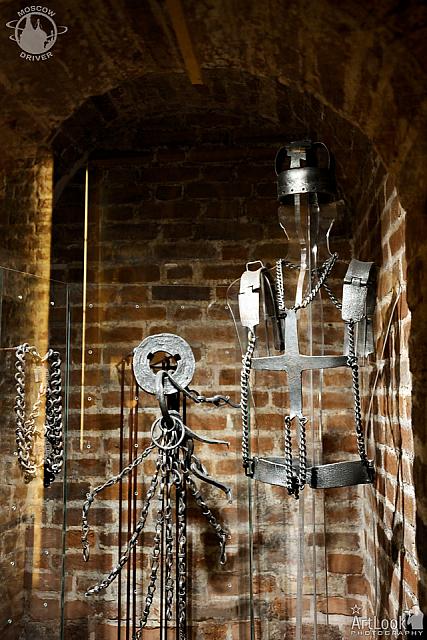
Another large facade icon, The Intercession of Our Lady, sized 2.6 by 3.8 m, was painted in the 1780s. It is now on the southerly wall of the Cathedral belfry.
Chapels of St. Basil’s
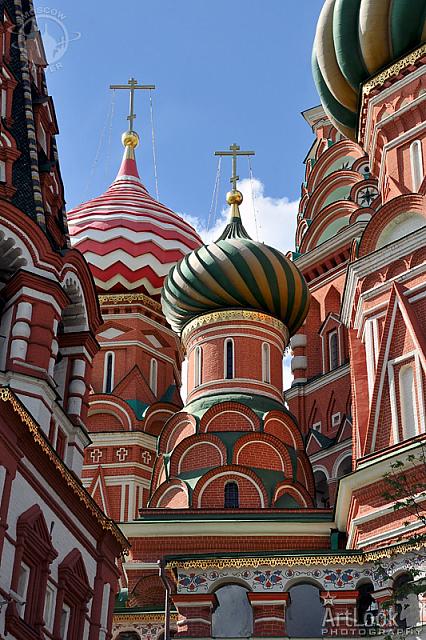
The cathedral has two roofed porches, but the only functioning entry for visitors is through St. Basil’s Church. Its existing iconostasis and murals date back to the late 19th - early 20th centuries. The precious shrine over St. Basil’s grave was looted by Polish soldiers during the Time of Troubles period; the existing shrine was made in 1896, displaying scenes from the saint’s life: Miracle on the Water and Miracle of the Putting Out of the Novgorod Fire. The first scene refers to a legend about how St. Basil saved a Persian ship in the Caspian Sea. During a horrible storm, Orthodox Christians, who were on the ship along with Persians, were praying for salvation. Suddenly they saw a naked man walking on the water, who pacified the sea. When the travelers came to Moscow, they recognized Basil the Blessed as their savior. According to another legend, the Czar offered Basil a goblet of wine three times, and Basil would dump the wine on the ground every time. When the Czar demanded an explanation, Basil claimed he had just put out a great fire in Novgorod. Some time later, Novgorodians confirmed they had seen a naked man who put out a major fire in their town with water.
There is another — more gruesome — tale frequently associated with the images of St. Basil. One of Basil’s rich worshippers once convinced him to accept an expensive fur coat as a gift. Some thieves decided to cheat Basil out of his fur coat. One of them feigned death, while the others asked Basil to donate something for their friend’s funeral. Basil covered the alleged dead body with his fur coat, saying: “Be dead now for your lies.” When Basil left, the thieves lifted up the coat and saw that their co-conspirator was, indeed, dead.
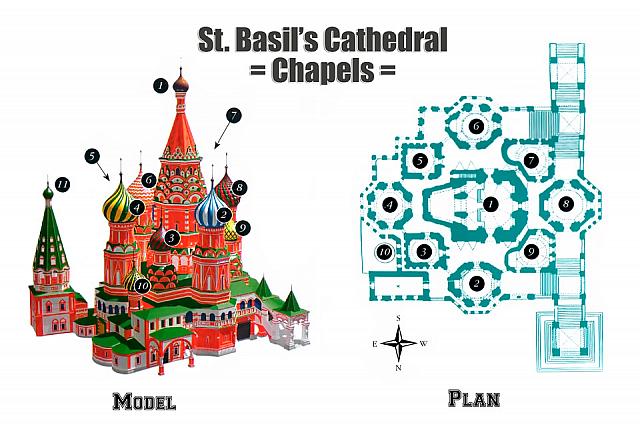
1. The Chapel of the Intercession of the Holy Virgin (main Chapel)
This Chapel was one of the earliest architectural experiments that placed two octagons sharing a ribbed roof on top of a square. This started a whole new trend in architecture. However, a tall structure like this with a small base plate is very difficult to heat, and cannot be used by many people praying at the same time, which is one of the reasons why very few churches like this were ever built.
The iconostasis now standing inside the Chapel of the Intercession of the Holy Virgin was transferred here in 1770 from the Chernigov Church inside the Kremlin after it was divested of its church status. The old iconostasis was sold to the village of Svistukha in the Kaliazin region for 70 rubles. The central Chapel icon — The Intercession of the Holy Virgin — dates back to that time, as do the other icons in this Chapel, including several images of Basil the Blessed.
The interior of the Chapel is decorated with restored 16th century murals. High above (the Chapel is 47.5 m tall), under the rotunda windows, the builders had inscribed the date when the Cathedral was completed: 29 June (Julian calendar) 1561. The southerly wall displays some 19th century icon art, and there is a fragment of an 18th century mural in the southwesterly corner.
2. The Chapel of the Holy Martyrs Cyprian and Justina (northern Chapel)
The iconostasis of the Chapel of Sts. Cyprian and Justina was created in 1784-1786, and its icons were painted at the same time. The icons in the bottom row tell the story of the two days of the Creation, when the Lord created water and the sky.
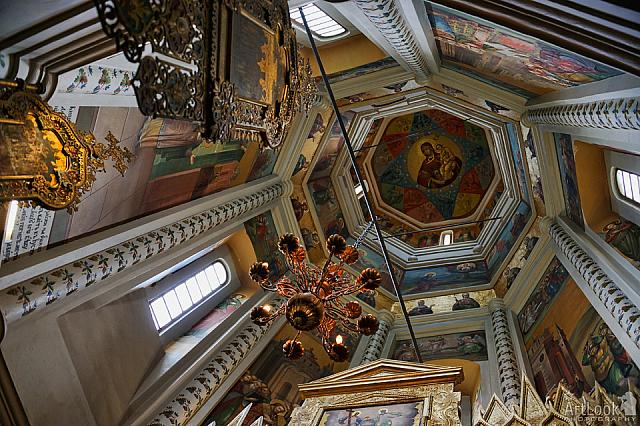
This Chapel houses two metal church gonfalons. One, bearing the image of Our Savior Facing Sergius of Radonezh and Varlaam of Khutyn, was introduced in 1913 in celebration of the 300th anniversary of the House of Romanov. The other, displaying the Intercession of the Holy Virgin with the namesake saints of members of the royal family, was placed in the Chapel in 1904 on the occasion of the birth of Prince Alexius.
3. The Chapel of the Three Patriarchs of Constantinople: Alexander, John and Paul the New (northeastern Chapel)
The five-level iconostasis at the Three Patriarchs’ Chapel was created in 1842-1849. In 1849, this Chapel was rededicated to St. Gregory of Armenia, which explains why the murals in the top row represent the life of the three Patriarchs of Constantinople, while the murals in the bottom row display scenes from the life of St. Gregory, the Enlightener of Armenia.
4. The Chapel of St. Nicholas (southern Chapel)
The original iconostasis of the Chapel of St. Nicholas burned down in the 1737 fire; the existing one was crafted in 1786. The Chapel icons date back to the same time, including the main icon of St. Nicholas of Velikoretskoe on the southern door of the iconostasis.
The 19th century murals illustrate a story from a Nikon-era chronicle about how the Icon of St. Nicholas of Velikoretskoe was brought to Moscow. The text on the northwestern wall tells the story of how the icon was received. Most of the floors in this Chapel are covered with 18th century white stone slabs, but on one part of the floor, the slabs have been intentionally removed to expose the original oak parquet.
5. The Chapel of the Holy Trinity (eastern Chapel)
The iconostasis at the Holy Trinity Chapel has been restored in its 16th century look, incorporating coeval icons by Moscow and Novgorod painters. The main icon — 16th century Icon of the Holy Trinity — is one of the oldest existing icons at the Cathedral of the Intercession.
The architecture and decorations in tins Chapel were also restored in their original 16th century look.
6. The Chapel of the Entry of Our Lord into Jerusalem (western Chapel)
The iconostasis of the Chapel of the I\n try of Our Lord into Jerusalem was moved here in 1770 from the Kremlin Church of St. Alexander Nevsky, abolished three years earlier. The majority of the icons in this Chapel were painted in the 18th century, but there are two 17th century icons here that are quite unique. One is the Icon of St. Alexander Nevsky with 33 scenes from his life, showing the holy and virtuous prince in his monastic vestments. Shortly before his death, Prince Alexander Nevsky took monastic vows and the name Alexius. The second icon, depicting the Entry of Our Lord into Jerusalem, may have been moved here from another major church in the Kremlin.
The interior of this Chapel is exactly the same as it was in the 17th century.
7. The Chapel of St. Alexander of Svir (southeastern Chapel)
At the Chapel of St. Alexander of Svir, the conjoined iconostasis has been restored in its original 16th century look, featuring an assortment of 16th and 17th century icons. The dominant image is an early 18th century icon of St. Alexander of Svir. Two sewed 18th century shrouds hang underneath the icon row.
The walls in this Chapel are painted to resemble brickwork, the same way they were in the 16th century.
8. The Chapel of St. Varlaam of Khutyn (southwestern Chapel)
The two-level conjoined iconostasis of the Chapel of St. Varlaam of Khutyn has been restored in its 16th century look, consisting of 16th-18th century icons, two of them completely unique: the 16th century icons of St. Varlaam of Khutyn and Vision of Sexton Tarasius.
The latter icon illustrates a legend about how the late St. Varlaam appeared before Tarasius, the sexton at the Khutyn Monastery, to predict the fire and famine to be visited on Novgorod for its sins in 1508. The saint also predicted a great flood, but the flood never happened thanks to St. Varlaam’s intervention before the Lord.
The whitewashed walls look exactly the same as they did in the 17th century.
9. The Chapel of the Holy Martyr Gregory, Bishop and Enlightener of Armenia (northwestern Chapel)
The restored conjoined iconostasis in the Chapel of St. Gregory of Armenia houses several 17th century icons by different painters, as well as a 16th century icon of John the Merciful. In 1788, a wealthy parishioner named Ivan Kislinsky had the Chapel rededicated in the name of St. John the Merciful, the Patriarch of Alexandria.
Cathedral Symbolism
It is not easy to unravel all the symbolism built by the old architects into a temple erected so many centuries ago, but we can guess a few things.
The four tall pillar Chapels around the central temple face the four parts of the world, while the four lower Chapels are positioned symmetrically in between. This suggests that the old architects designed the cathedral as two squares, one inside the other with a 45 degree shift. This shape forms an eight-pronged star, one of the symbols of the Holy Virgin usually displayed on her robes. The same star is repeated in the layout of the octagonal tent-like roof of the Chapel of the Intercession. It is believed that the nine-dome temple is in itself a symbol of Our Lady as a celestial patron of the Russian Orthodox Church. The cathedral is filled with Virgin Mary symbolism.
Another set of symbolism is linked to the concept of Moscow as “The Third Rome” and heir to the former hubs of Orthodox Christianity, which gained circulation during the reign of Ivan the Terrible. Moscow was to become an agglomeration of sanctity, saints and sacred objects. The Cathedral of the Intercession with its many onion domed Chapels that look like a small town in its own right was conceived as a symbol of the earthly and heavenly city of Jerusalem.
Read Square – Russia’s Heart
Novodevichy cemetery.
- Walking Tour with Repeat Client on The Red Square Today, on February 8th, 2007, I provided walking tour around a historical part of Moscow city including the Red Square for my repeat client from Germany, Romy Brock. It is her 6th business trip to Moscow and this time she found some spare time between her meetings to walk around the famous Moscow attractions together and take some pictures of our memories (tomorrow I have to see her off again).
- Season's Gretings 2011 Every year when we all feel the breath of the coming winter holidays, like all people in the world, I want to thank all of my friends throughout the world for our friendship, for all the minutes they’ve spent in Moscow with me this year, and for all the things we have explored together.
- Read Square One can’t come to Russia and not visit the Red Square – a point where all tourists make the acquaintance with our country, a point where Moscow's major streets — which connect to Russia's major highways — originate from. It’s a cultural, historical and political centre of the capital and all Russia.
- Best Attractions You Must See in Moscow Moscow offers plenty of sights for travelers so that it is very important to know and plan before your trip visiting its must-see sights and attractions you certainly shouldn’t miss!
Related Photos:

About Me in Short

My name's Arthur Lookyanov, I'm a private tour guide, personal driver and photographer in Moscow, Russia. I work in my business and run my website Moscow-Driver.com from 2002. Read more about me and my services , check out testimonials of my former business and travel clients from all over the World, hit me up on Twitter or other social websites. I hope that you will like my photos as well.
See you in Moscow!
- Russian Visa Invitation Letter Support
- Moscow Airports: A Virtual Guide (Written by a Real-life Guide)
- Exploring Moscow for the First Time? A Personal Guide is What You Need!
- Don’t miss a great chance of seeing fairy-tale town of Suzdal
Recently Posted:

Innovation Center Skolkovo – Territory of the Future
Develompment of the Skolkovo Innovation Center, the modern scientific and technological innovative complex located in the Mozhaysky district of the Western Administrative District of Moscow of an area of approximately 400 hectares.
Featured Photo Albums
- Picture of a Day
- Moscow Must-See Sights & Attractions
- Tour Guide and Driver Portfolio
- Photographs of Dear Clients & Friends
Last Published Photo:
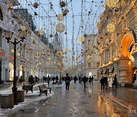
Lights of Nikolskaya Street in Winter Twilight
People walking up and down Nikolskaya street in winter twilight decorated with LED creating a festive atmosphere in any season. The picture is taken near GUM building (at the right) and Red Square.
Take One of Exciting Tours:
- Moscow Highlights
- Discovering the Golden Ring of Russia
- Arts & Culture Tours
- Night Tour of Moscow
Related Information:
- Terms and Conditions
- Recommended Tour Guides
- Useful Links


- What to see
- Monuments and attractions
Saint Basil's Cathedral
Built in the mid-16th century under Ivan the Terrible, St Basil's Cathedral is the symbol of Moscow and, often of Russia as a whole. Its brightly coloured, exquisitely carved architecture is the stuff of fairytales.
Saint Basil's Cathedral in Moscow is a proud survivor of the city's tumultuous history. Rising majestically from Red Square , it provides a striking contrast to the monochrome buildings characteristic of the Soviet era that fill much of the city. It has remained standing despite several fires, Napoleon's invasion and the demolition of churches like the Cathedral of Christ the Saviour under Stalin.
An iconic building
Enchanting visitors with its vibrant mix of bright colours, the towers topped with differently designed onion domes - some swirled like ice creams, some textured with diamond patterns - St Basil's Cathedral is the most famous building in Moscow , offering an unforgettable postcard image for everyone who visits the city, whether at day or night.
Inside the unique exterior is a small temple made up of a labyrinth of nine different chapels , one of which is topped by the central bell tower. Each small chapel is exquisitely decorated with Orthodox iconology, gilt details and colourful murals .
One of Moscow's most precious treasures
A UNESCO World Heritage Site and internationally recognised symbol of Russia, St Basil's is one of Moscow's most spectacular monuments , a magnificent landmark that has been present for almost 500 years of the city's history .
During your trip to Moscow, you're bound to pass by the cathedral on numerous occasions: it's definitely worth seeing both in the day , to fully admire its vivid rainbow of colours, and at night , to see the lovely illuminations after dark. While it is one of of the capital's must-see monuments, if you're short on time or have a tight budget, just stick to seeing the outside.
It's often common to confuse the cathedral as part of the Kremlin , which is located just next door, but they are completely separate. As well as the Kremlin, St Basil's central location means you can combine it with a visit to Lenin's Mausoleum , the GUM or the Moscow's State Historical Museum .
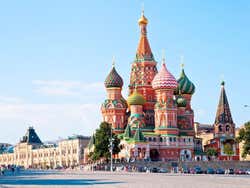
Red Square.
Daily from 11 am to 5 pm (may vary depending on the season).
Adults: ₽ 700 ( US$ 7.90) (500 RUB for citizens of Russia and the EAEU). Young people between 16 and 18 years and students: 150 RUB. Children under 16 years old: free entry.
Closest metro to Red Square : Ploschad' Rovulyutsii (line 3, blue).
You may also be interested in

Pushkin Museum
Located in the heart of Moscow, the Pushkin State Museum of Fine Art is one of the most important in Russia, home to an enormous collection of paintings, sculptures, archaeological objects and more.

Tretyakov Gallery
Founded by a Muscovite merchant in the mid-19th century, the State Tretyakov Gallery is one of the largest collections of Russian fine art in the world.

IMAGES
VIDEO
COMMENTS
Tours Cathedral (French: Cathédrale Saint-Gatien de Tours) is a Roman Catholic church located in Tours, Indre-et-Loire, France, and dedicated to Saint Gatianus.It is the seat of the Archbishops of Tours, the metropolitan cathedral of the Tours ecclesiastical province.It was built between 1170 and 1547. At the time construction began, the church was located at the south end of the bridge over ...
Cloisters of la Psalette. The cloister of la Psalette is on the north side of the cathedral, and entered through the cathedral - a small entrance charge is payable for this part of your visit. Built in the 15th and 16th centuries, the cloister is built over two levels and incorporates elements in the gothic style and also parts that are in the ...
Guided tours. Saint-Gatien's Cathedral does not offer guided tours, but you can book group tours (minimum 6 people) in French or English with the Présence Cathédrale association by clicking here. Otherwise, the association's mediators are present in the cathedral from Easter weekend to November 11 (date of the winter Saint-Martin's Day), on ...
Tours Cathedral. Tours Cathedral: A Historical Jewel in the Heart of France. Nestled in the picturesque city of Tours, France, the Tours Cathedral, officially known as "Cathédrale Saint-Gatien de Tours," stands as a magnificent representation of Gothic architecture and the city's rich religious heritage. The construction of the cathedral began ...
Browse Getty Images' premium collection of high-quality, authentic Tours Cathedral stock photos, royalty-free images, and pictures. Tours Cathedral stock photos are available in a variety of sizes and formats to fit your needs.
Cattedrale di Tours, ante 1914 - Archivio Meraviglioso ICM BC1914n42f9.jpg 427 × 999; 317 KB Chevet Cathédrale de Tours au matin (juin 2023).JPG 3,008 × 2,304; 4.81 MB Clocher Sud Cathédrale St-Gatien de Tours au matin (juin 2023).JPG 2,283 × 3,056; 3.6 MB
Cathédrale Saint-Gatien de Tours, is dedicated to the first bishop of the city and is a 'must-see' when visiting the Loire Valley. The current cathedral sits on the site of a number of predecessors all of which were damaged by fires. One in 1166 during the conflict between Louis VII of France and Henry II of England (who also ruled over the ...
The Tours Cathedral (Cathédrale Saint-Gatien de Tours), dedicated to Saint Gatien, its first bishop, was begun about 1170 to replace the just-started cathedral that burned down in 1166 during the quarrel between Louis VII of France and Henry II of England.. Work on Tours Cathedral proceeded at a leisurely pace over the centuries until 1547. The lowermost stages of the west towers belong to ...
A true masterpiece of Gothic art, the Saint-Gatien cathedral sits in the heart of old downtown Tours, in Indre-et-Loire. Today listed building, it was built between the thirteenth and sixteenth century on the remains of an ancient Gallo-Roman city. Under royal patronage, the building has seen all the kings of France since Louis VII become ...
A church has stood in this approximate location since the 5th century, after Saint-Martin of Tours died in 397 AD and a small oratory was built over his burial site in 437 AD. By the end of the 5th century a basilica had been built and in the following centuries this was further enlarged. At the beginning of the 9th century the basilica was ...
Photo gallery of Tours Cathedral in Tours, France. This gallery of 5 photos accompanies our article on Tours Cathedral.Click any image to enlarge or start at the beginning for a virtual tour.
Largely pedestrianised, the little cobbled lanes are perfect for snapping stunning medieval-esque photos. Tours Cathedral. Widely regarded to be one of the most beautiful cathedrals in France, Tours Cathedral is officially known as Cathédrale Saint-Gatien and was constructed between the 12th and 16th-centuries.
Dates & prices. 25 Sep - 03 Oct 2024. 23 Apr - 01 May 2025. 17 - 25 Sep 2025. Itinerary for The Cathedrals of England, from the leading specialist in cultural tours. Call +44 (0)20 8742 3355 to find out more.
Guided tours are typically available during weekdays between 10:00 a.m.- 3:00 p.m., pending other scheduled events. Please contact the tour office at 314-373-8241 for availability. We also host a tour on most Sundays following the completion of the noon Mass. The Sunday Tours are open to the public and do not require reservations unless you are ...
Cathedral Tour Stop Four: Notre-Dame de Laon. If you want to see one of the first of the great Gothic cathedrals, go to Laon (pronounced 'Lon'). It's a beautiful cathedral built in the second half of the 12th century. It set the style for many of the cathedrals that followed, including Chartres, Reims and Paris.
Browse 726,800+ cathedral tours stock photos and images available, or start a new search to explore more stock photos and images. ... Room for copy space. cathedral tours stock pictures, royalty-free photos & images. Urban crowd and futuristic architecture in the city, London, UK.
Practical Guide & Tips For Toledo Cathedral. Address: Calle Cardenal Cisneros, 1. The entrance is to the right of the front facade of the cathedral. Hours: Monday through Saturday from 10:00 am to 6:30 pm. Sundays and holidays from 2:00 pm to 6:30 pm. Tickets: 12 euros.
The cathedral of St. Basil with its unusual combination of domes, artful forms and overall harmony is a superb, unmatched masterpiece of Russian architecture, and probably the most celebrated and mysterious temple in Russia. Its real name is the Cathedral of the Intercession of the Holy Virgin (Pokrovsky Sobor), Which is on the Moat (the Aloisius Moat, running along the Kremlin wall nearby ...
The Cathedral of Vasily the Blessed (Russian: Собор Василия Блаженного, romanized: Sobor Vasiliya Blazhennogo), known in English as Saint Basil's Cathedral, is an Orthodox church in Red Square of Moscow, and is one of the most popular cultural symbols of Russia.The building, now a museum, is officially known as the Cathedral of the Intercession of the Most Holy Theotokos ...
Saint Basil's Cathedral in Moscow is a proud survivor of the city's tumultuous history. Rising majestically from Red Square, it provides a striking contrast to the monochrome buildings characteristic of the Soviet era that fill much of the city.It has remained standing despite several fires, Napoleon's invasion and the demolition of churches like the Cathedral of Christ the Saviour under Stalin.
On this map you can see exactly where St. Basil's Cathedral is located: St. Basil's Cathedral and its history. St. Basil's Cathedral on Red Square has its official name "Sobor Pokrova Presvjatoy Bogoroditsy na Rvu", which in English means something like: "The Intercession Cathedral of the blessed virgin Mary on the Moat".